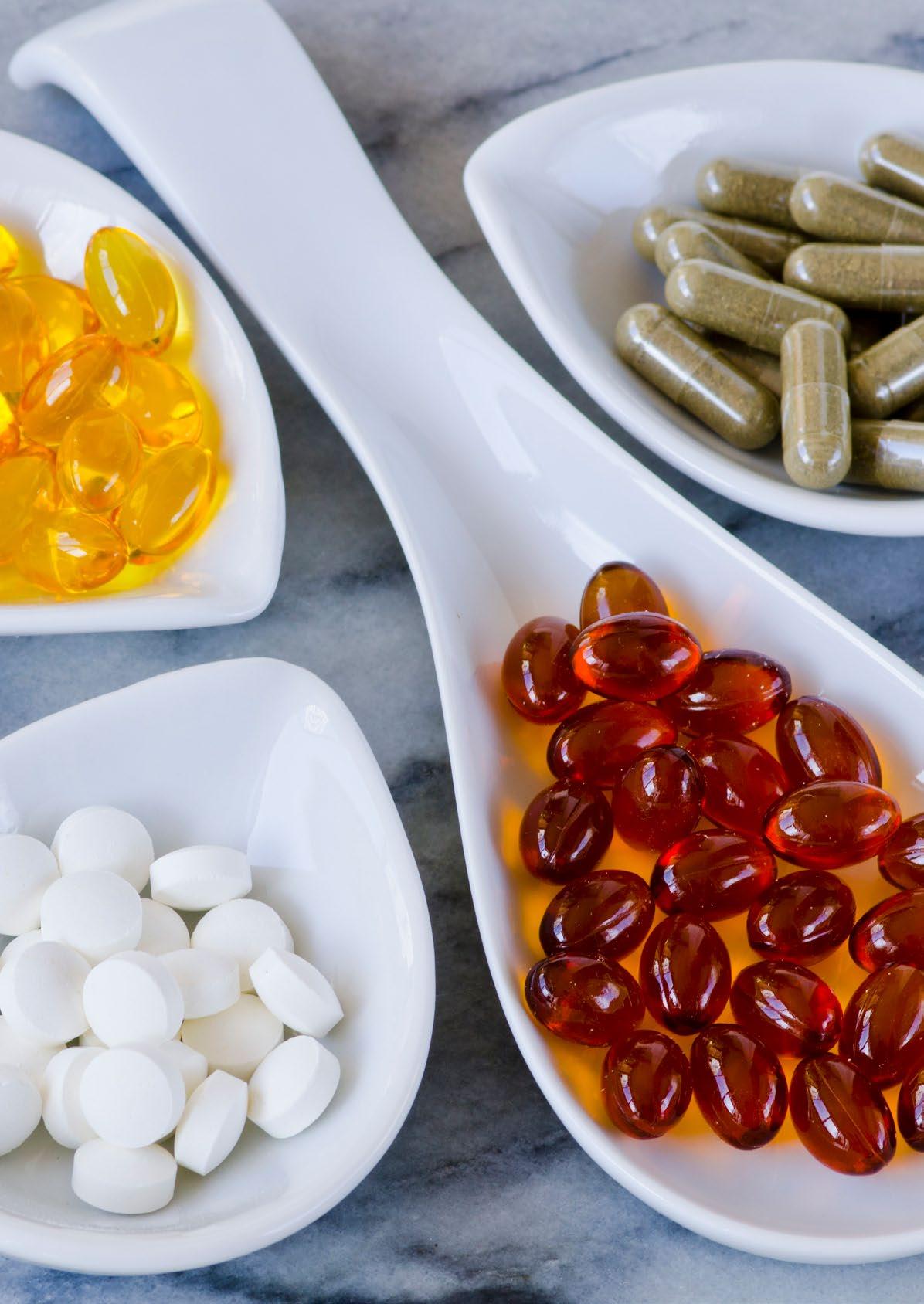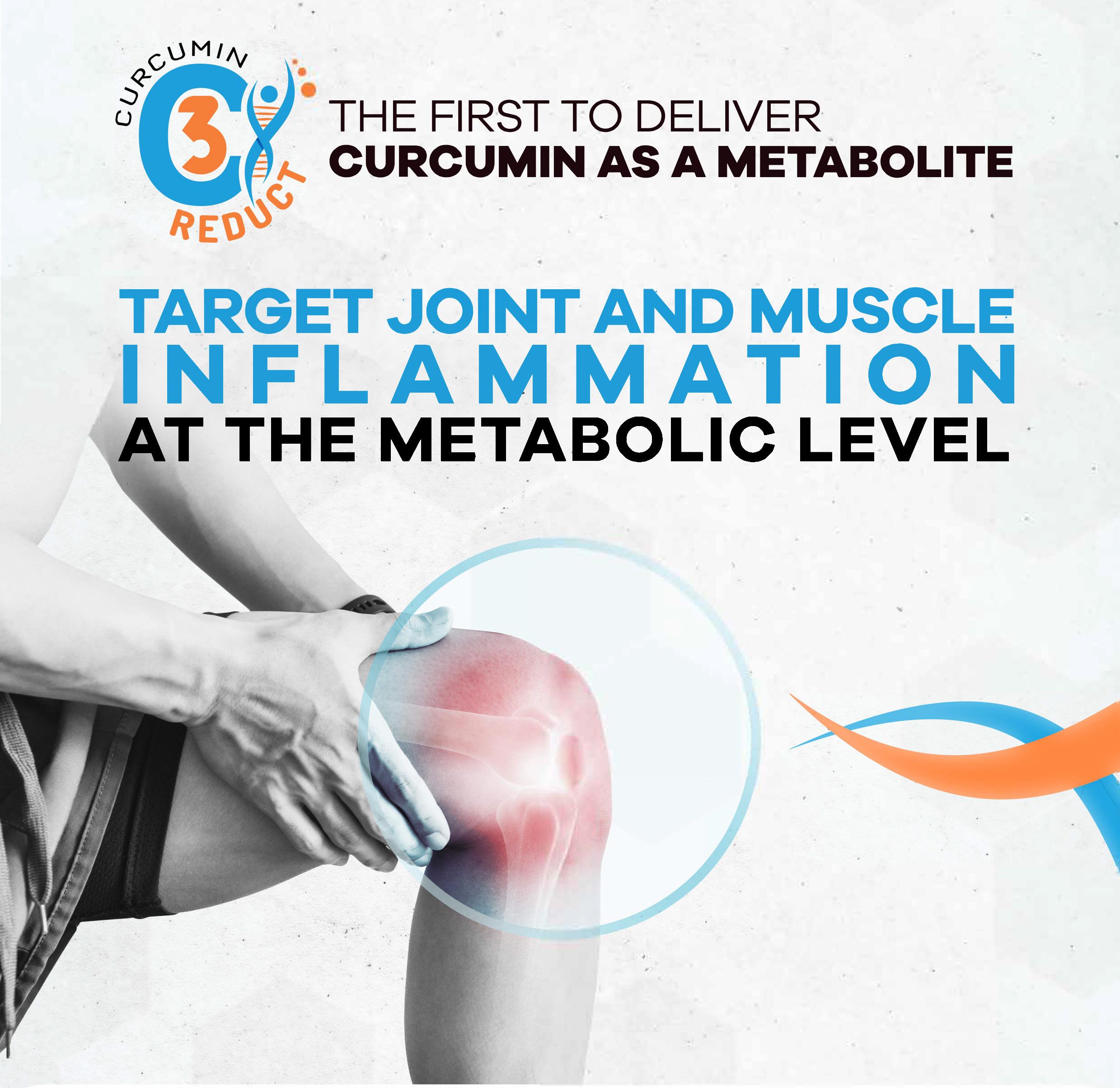

Editor's word

Welcome to the No.9 March/April edition of B2B Nutramedic&Cosmetics Digital Magazine. In this issue we unravel the intricate relationship between butyrate and the gut-brain axis, explore innovative strategies in food supplement development, and delve into the realm of musculoskeletal health enhancement.
We also shed light on navigating cosmetic claims regulations, spotlighting the benefits of pomegranate seed oil as a nutraceutical ingredient.
As always, we aim to provide you with valuable insights and inspiration to fuel your innovation and growth in the dynamic world of nutraceuticals and cosmetics. We hope you find this issue informative and thought-provoking, and we look forward to continuing this journey of exploration with you. Don’t miss the opportunity to dive into a treasure trove of industry-specific content and resources waiting for you on our website portal, https://nmc-magazine.com/
Best regards,
 Daria Šurić, MPharm EDITOR-IN-CHIEF B2B Nutramedic&Cosmetics Magazine
Daria Šurić, MPharm EDITOR-IN-CHIEF B2B Nutramedic&Cosmetics Magazine
Contents





4 Butyrate and the Gut-Brain Axis
8 Kemin: Partners for Better Health
12 Eriomin® and Liver Function
13 Introduction to Food Supplement Development
18 Impact of MKARE® on Tendons and Flexibility
Bimonthly digital magazine for industry professionals in health, nutrition and cosmetics sector
Bimonthly digital magazine for industry professionals in health, nutrition and cosmetics sector
Ingredients and raw materials / Contract manufacturing
Ingredients and raw materials / Contract manufacturing
Equipment & Packaging / Services / Industry events
Equipment & Packaging / Services / Industry events
www.nmc-magazine.com
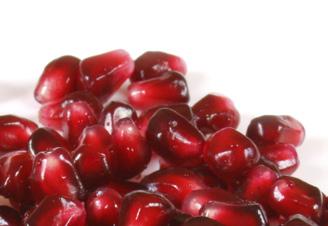
19 Pomella®’s New Research Supports Gut Health
info@nmc-magazine.com
info@nmc-magazine.com
Publisher: Darmell d.o.o.
Publisher: Darmell Ltd.
Cvjetna cesta 11, 10000 Zagreb, Hrvatska
Cvjetna cesta 11, 10000 Zagreb, Croatia
Mob: + 385 91 68 12 444
darmell@protonmail.com
Mob: + 385 91 68 12 444 darmell@protonmail.com www.dar-mell.com
www.dar-mell.com
Supported by www.inpharma.hr

20 Enhancing Musculoskeletal Health
The publisher does not assume responsibility for the opinions and data that the authors present in the magazine, as well as for the data and materials provided by companies for publication in texts and advertisements. It is not allowed to reuse any part of the content without the prior consent of the publisher.
The publisher does not assume responsibility for the opinions and data that the authors present in the magazine, as well as for the data and materials provided by companies for publication in texts and advertisements. It is not allowed to reuse any part of the content without the prior consent of the publisher.

27 Study: Levagen®+ May Help Migraine Sufferers



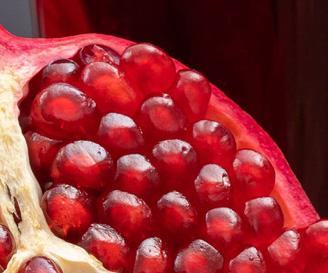



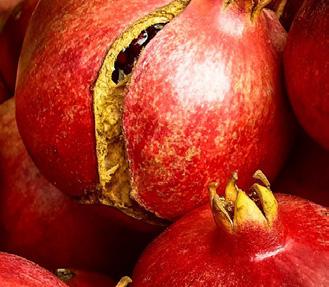


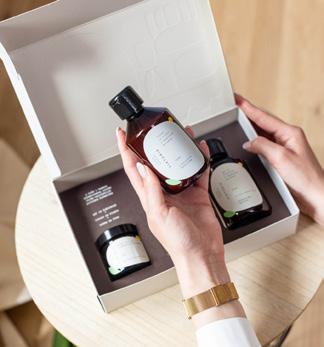



Butyrate and the Gut-Brain Axis
The text explores the pivotal role of butyrate, a short-chain fatty acid produced in the gut, in regulating various physiological functions, particularly its influence on the gutbrain axis. Butyrate serves as a key mediator between the gut microbiome and the host, impacting metabolic, immunological, and neurological processes. Its potential therapeutic applications span from gastrointestinal disorders to neurological conditions, highlighting its significance in maintaining overall health and well-being.

AUTHOR:
AndrijaKaračić, M.D., specializing in abdominal surgery and the founder of the Gut Microbiome Center in Zagreb
The digestive system, especially the intestines, is the primary interface of our body for interaction and exchange of nutrients with the surrounding world. Evolutionarily, communities of microorganisms have settled at this interface, forming a spatially large and extremely complex ecosystem called the gut microbiome, which is in symbiosis with the host.
Thanks to insights accumulated over the past decade, we now know that the presence, metabolism, and activity of the gut microbiome have a regulatory function on human physiology and the functions of almost all organ systems. This includes the central nervous system. To understand the interaction between the gut microbiome and the central nervous system, the gut-brain axis model is used, which involves various pathways of communication through endocrine, nervous, and immune signals, as well as direct communication through bacterial metabolites that reach the central nervous system.
Metabolites in the intestines mainly arise from microbial fermentation. Microbial fermentation of fibers, carbohydrates, and proteins in various parts of the colon involves complex processes for obtaining energy. These processes mainly occur anaerobically and are necessary for the growth and development of a large number of intestinal microorganisms, including bacteria and fungi. However, many other roles of microbial metabolites have been established today.
Because of its pleiotropy, among the most important bacterial metabolites are short-chain fatty acids (SCFAs), small organic acids with a single carboxyl group with fewer than 6 carbon atoms, which are produced by anaerobic fermentation in the intestines.
Butyric acid is a short-chain fatty acid (SCFA) with four carbon atoms (IUPAC name: butanoic acid). Besides butyric acid, acetic and propionic acid are also classified as SCFAs.
Butyric acid is the most important mediator in communication between the gut microbiome and the host among SCFAs due to its versatile functionality. From the liver to the central nervous system, the
production of this molecule by the gut microbiome regulates numerous physiological functions. The idea that we can modify its levels in the body through diet, supplementation, and lifestyle changes makes it even more fascinating.
Butyric acid, named after the Greek word for butter, is known for its intense smell of butter or spoiled milk. This scent occurs during the hydrolysis of triglycerides from fats catalyzed by lipase, either in butter, sweat (skin bacteria), or the stomach (salivary/ stomach lipase), when butyric acid is released from them.
Butyric acid can enter the body in two ways. Either through diet by consuming foods rich in tributyrin triglyceride, such as butter (3g/100g), cheese (goat 1-1.8g/100g), and other dairy products, which lipases will degrade. Tributyrin in dairy products is of microbial origin, formed by the fermentation of cellulose in the rumen of cattle.
In the systemic circulation, under physiological conditions, butyrate usually comes from the endogenous gut microbiome. In the human gut microbiome, butyric acid is produced by anaerobic microbial fermentation of dietary fibers (polysaccharides) by so-called butyrate producers (Lachnospiraceae, Roseburia) from legumes, fruits, nuts, and cereals. The main metabolic pathways for production are through acetyl-coenzyme A from pyruvate or from lactate or through crotonyl-coenzyme A from glutarate, lysine, or succinate. This is why some butyrate is produced apart from the fermentation of exogenously ingested polysaccharides by interaction within the microbial ecosystem from other substrates. Cross-feeding of lactate and butyrate has been observed between butyrate-producing bacteria and lactate-producing bacteria, Bifidobacterium and Lactobacillus . In addition to this, butyrate can be produced by the degradation of mucins by, for example, Roseburia intestinalis and Eubacterium rectale . Butyrate-producing bacteria are not closely related (monophyletic group) which is why the possibility of butyrate production through the abovementioned metabolic pathways is considered an evolutionary advantage used by different prokary-
otes. However, most producers belong to the phylum Firmicutes , especially the class Clostridia , clusters Clostridium IV and XIVa.
It is interesting to note that butyric acid is also present in breast milk, and infants ingest about 30 mg of butyric acid per kilogram of body weight.
Butyric acid occurs in nature in two isoformsn-butyric and iso-butyric acid. Since the concentrations of n-butyric acid in stool are five to eight times higher than in urine and the fact that only n-butyric acid has molecular and pharmacological activity, the focus is on n-butyric acid.
Since butyric acid is mainly present in the deprotonated form in the systemic circulation, it is often called butyrate. In the intestines, however, butyric acid contributes to lowering the pH value. The pH value as a determinant of the intraluminal milieu of the intestine is crucial for the efficiency of butyrate production: the concentration of butyrate is inversely proportional to the pH value. Butyrogenic bacteria that produce butyrate multiply at lower pH values compared to gram-negative species of the Bacteroides genus, which prefer a higher pH.
Butyrate, the anionic form of dissociated butyric acid, is involved in various physiological processes. From the regulation of energy homeostasis and related body weight to the regulation of the immune system, carcinogenesis, and the functioning of the central nervous system. Current scientific knowledge even suggests that the immunity and metabolism of the host depend on butyrate as a regulator of their processes.
Butyrate, like other SCFAs and chemically related ketone bodies such as β-hydroxybutyrate, has promising effects in the treatment of various diseases:
from metabolic disorders such as obesity and insulin resistance to inflammatory bowel diseases, colorectal cancer to neurological diseases. Butyrate has been used experimentally in pharmacology and neuroscience in doses ranging from 100 to 1200 micrograms per kilogram of body weight.
Butyrate is considered a key factor in the interaction between the host and the gut microbiome, especially in the gut-brain relationship.
Butyrate exerts its activity by binding to receptors
GPR43/FFAR2, GPR41/FFAR3, GPR109a/HCAR2, and by transport through MCT1/SLC16A1 and SMCT1/SLC5A8. These receptors are located on:
epithelial cells of the intestine - colonocytes and enteroendocrine cells
• liver cells – hepatocytes
• nerve cells - in the vagus nerve, enteric nervous system, central nervous system
• immune cells - regulatory T cells, monocytes, neutrophils.
In addition to acting on the above receptors in the mentioned cells, the mechanisms of action of butyrate also involve its use by cells as an energy source through mitochondrial β-oxidation processes and the inhibition of histone deacetylase (HDAC) and thus the promotion of genetic expression (epigenetic modulation). Interestingly, butyrate is the first endogenous substance discovered to have inhibitory activity on HDAC and is the most potent natural inhibitor of it. However, not all mechanisms of butyrate action have been fully elucidated yet.
Considering that almost all butyrate in the body is actually produced in the intestines, its main action is in the digestive system and on organ systems close-

ly related to it, such as the immune and enteric nervous systems. The largest number of receptors for butyrate is found on colonocytes, and their number is proportional to the concentrations of butyrate within the intestines. Butyrate is the main source of energy for colonocytes through mitochondrial β-oxidation. In the digestive system, butyrate also plays an important role in the integrity of the intestinal barrier. Butyrate and other SCFAs affect the expression of tight junction proteins that connect intestinal membrane cells. Through the activation of 5-HT3 receptors on enteroendocrine cells, butyrate stimulates serotonin production, which affects intestinal motility. Additionally, butyrate in enteroendocrine cells stimulates the production of GLP-1, peptide YY, and other peptide hormones that regulate appetite and metabolism. Only micromolar amounts of butyrate reach the systemic circulation. The highest concentration outside the digestive system is in the portal vein. In the liver, a large portion of butyrate is used for energy needs through β-mitochondrial oxidation, where it metabolizes into ketone bodies and acetyl-coenzyme A. In peripheral circulation, the concentration of butyrate is only 20% of that in the portal vein. Excess butyrate is excreted in the intestines, and concentrations in stool range from 3.5 to 32.6 grams per kilogram of stool.
Butyrate is an important immunomodulator. It is believed that due to the coevolution of the gut microbiome and the host immune system, the immune system has become very sensitive to the action of butyrate. Human immunity matures and then is regulated by the microorganisms of the human body, their mere presence, and their metabolites. Butyrate, like other metabolites of the gut microbiome, is signaling molecules that inform the immune system about the composition and activity of the gut microbiome. Depending on the levels of butyrate with which the immune system in the intestines and circulation
comes into contact, it will increase or decrease its activity. A rapid decrease in butyrate indicates an increase in pathogenic bacteria, which requires increased activity of the immune system. Butyrate itself has a proven anti-inflammatory potential. Through the inhibition of HDAC and activation of FFAR2 receptors, butyrate promotes the maturation of regulatory T lymphocytes that regulate the proinflammatory immune response. On the other hand, through the inhibition of HDAC, butyrate reduces the levels of CD4+ and CD8+ T lymphocytes, which are crucial for the pro-inflammatory response.
Physiological levels of butyrate in the body indirectly affect the function of the central nervous system through the regulation of the immune response and stimulation of the vagus nerve. Low concentrations of butyrate in circulation and the high selectivity of receptors in the central nervous system are reasons why butyrate probably does not directly affect the central nervous system. However, changes caused by butyrate in the immune system are reflected in the immune milieu of the brain, and direct stimulation of the peripheral nervous system, vagus nerve, and enteric nervous system indirectly affects brain function. Besides the integrity of the intestinal barrier, butyrate and other SCFAs also have a positive, very likely indirect effect on the integrity of the blood-brain barrier. The application of exogenous butyrate as a drug has proven effective in experimental conditions, which is why it is considered a potential neuropharmacological agent, primarily due to its ability to modulate epigenetics (inhibition of HDAC). Many neuropsychiatric diseases are associated with increased proinflammatory response in the body, and by reducing it, butyrate may be effective in therapy. Through the inhibition of HDAC, butyrate affects the activity of microglia and thus achieves its neuroprotective effects. However, the inhibition of HDAC by butyrate is also associated

with increased neuroplasticity due to increased expression of proteins crucial for memory formation in the context of neurodegenerative diseases, addiction, and learning. However, in the context of treating brain diseases, many aspects of the central action of butyrate are not yet fully understood.
The volatile butyrate, originating from the gut microbiota, may also be involved in the host's behaviour, i.e. social communication. Butyrate has one of the most intense smells. Two hypotheses try to explain this phenomenon: one claims that evolution has led to the association of this smell with biological decay, fermentation, and toxins, and the other claims that the presence of butyrate in the smell indicated a good composition and activity of the gut microbiome, and therefore good health. The proportion of volatile SCFAs, which is associated with the composition of the gut microbiome, is an important component of the individual's "olfactory fingerprint" as confirmed in animal studies. The smell is extremely important for social interaction, which is why it is believed that due to its influence on the olfactory fingerprint, there is also a potential role of butyrate in social interaction. This claim is supported by research on the scent glands of hyenas: the microbiome within the glands, dominated by bacteria from the Firmicutes phylum that produce volatile fatty acids, depending on its composition, affected the scent characteristics of hyenas related to gender and species.
We will likely learn much more about butyrate in
the coming years. The biggest questions concern its mechanisms of action, especially regarding the central nervous system. Butyrate has great potential in treating many diseases: from functional and inflammatory bowel diseases to various diseases of the central nervous system. It is not surprising when we know that butyrate is a regulator of gut health, metabolism, and the immune system, and in addition to all that, it has the ability of epigenetic modulation. While butyrate can be introduced from the outside, it seems that perhaps the most important thing is to ensure adequate endogenous production of butyrate in our gut microbiome.
Adapted from: Stilling R.M. et al., The neuropharmacology of butyrate: The bread and butter of the microbiota-gut-brain axis? Neurochemistry International, 2016.

Centar Mikrobiom d.o.o.
Sky Office, Toranj B
R. F. Mihanovića 9, Zagreb, Croatia
Mob.: + 385 98 13 73 344
Tel.: + 385 1 78 99 694
https://www.ccm.hr/

Partners for Better Health: THE GUT AND THE IMMUNE SYSTEM

CONSUMERS MAKING THE CONNECTION
When it comes to health and wellness, consumers have one goal in mind—staying healthy. Having strong and well-functioning immune and gastrointestinal systems are essential to meeting that goal. Today’s wellness-minded consumers want multi-functional health products that focus on more than just one aspect of their overall health. In fact, the link between immune and GI health is recognized by 79% of consumers worldwide,1 and about 40% of consumers report suffering from GI health problems on a regular basis.2 Adding common issues such as poor diet, sleep irregularity and stress to this gut and immune equation can result in an unbalanced system.3
THE GUT-IMMUNE CONNECTION
The immune and digestive systems are not competing for a sole position when it comes to well-being, but rather, they are interconnected and work together to maintain overall health. These systems complement each other in several ways.
The digestive system absorbs nutrients from the food we eat including vitamins and minerals needed for immune function. A well-nourished body is better equipped to mount an immune response. The gut plays a crucial role in immunity, as it contains a significant amount of the body’s immune cells and is involved in the immune surveillance and response. The immune system identifies and neutralizes potential threats that may enter the body through the gut.4
The gut microbiota, which consists of trillions of commensal bacteria, fungi and viruses, plays a vital role in modulating immune responses within the gut. The immune system, in turn, helps shape the composition and diversity of the gut microbiota. This bidirectional communication between the gut microbiota and the immune system is essential for maintaining immune homeostasis.5
In fact, approximately 70% of the entire immune system is located around the gut.6
THE INTESTINAL BARRIER
The intestines provide the largest interface between our bodies and the environment. All along the intestinal wall is a structure forming a boundary between what remains in the gut cavity and what gets absorbed: the intestinal barrier This barrier is responsible for controlling the ins and outs of external substances and molecules.7
One way this is managed is through the presence of structures or ‘gates’ called ‘tight junctions’ that keep intestinal cells tightly linked together, allowing water and nutrients to pass through and keeping harmful substances out. However, if the intestinal barrier is compromised, this can lead to increased permeability causing a miscommunication between the systems, allowing things such as food particles, bacteria and toxins to penetrate the tissues that would otherwise be kept out.8,9
Gut Permeability
factors, including aging,10 diet, sleep and stress are attributed to reshaping the gut bacteria’s composition.3 In particular, western diets low in fiber have been shown to negatively alter intestinal permeability 3
THE BENEFITS OF GOOD GUT HEALTH
Taking care of gut health doesn’t just impact your gut, but also your immune system and overall wellbeing. Improving intestinal barrier function can result in better immune response, transport, food and water absorption along with less susceptibility to unhealthy conditions.8,9 11


Supporting Gut Health
It’s not enough to focus purely on gut or immune health. Rather, it is important to target and support both immune and gut health when looking at overall health and wellness, as the two are so closely linked. By focusing on both, you help strengthen the other.
Consumers can follow a variety of everyday practices to support gut and immune health, including:
Eating a balanced diet, high in fiber12
Staying hydrated13
Managing stress14
Getting enough sleep15
Exercising16
Supplementation17
Supporting gut and immune health can help people live healthier lives.
FEED THE GUT-IMMUNE CONNECTION
Kemin offers science-backed ingredients shown to support gut and immune health, including:
BetaVia™
Algae-source beta 1,3 glucans that help to prime key immune cells, shape the microbiome and protect intestinal barrier integrity.18-22
ButiShield™
An encapsulated form of calcium butyrate providing a controlled release of butyric acid to support gut health.23-26
Working on a gut or immune health formulation? At Kemin, we help formulators develop new health and wellness products to improve the health and nutritional needs of consumers around the world.
For more on how Kemin Human Nutrition & Health can help improve your gut or immune health product, visit kemin.com
SOURCES
1 FMCG GURUS Digestive Health in 2022 and Beyond – Global Report; 2022.
2 Sperber, A.D.; Bangdiwala, S.I.; Drossman, D.A.; Ghoshal, U.C.; Simren, M.: Tack, J.; Whitehead, W.E.; Dumitrascu, D.L.; Fang, X.; Fukudo, S.; et al. Worldwide Prevalence and Burden of Functional Gastrointestinal Disorders, Results of Rome Foundation Global Study. Gastroenterology 2021, 160, 99-114.e3, doi: 10.1053/j.gastro.2020.04.014.
3 Madison, A., & Kiecolt-Glaser, J. K. (2019). Stress, depression, diet, and the gut microbiota: human-bacteria interactions at the core of psychoneuroimmunology and nutrition. Current opinion in behavioral sciences, 28, 105–110
4 Takiishi, T.; Fenero, C.I.M.; Câmara, N.O.S. Intestinal Barrier and Gut Microbiota: Shaping Our Immune Responses throughout Life. Tissue Barriers 2017, 5, doi:10.1080/21688370.2017.1373208.
5 Wu HJ, Wu E. The role of gut microbiota in immune homeostasis and autoimmunity. Gut Microbes. 2012 Jan-Feb;3(1):4-14. doi: 10.4161/gmic.19320. Epub 2012 Jan 1. PMID: 22356853; PMCID: PMC3337124.
6 Vighi, G.; Marcucci, F.; Sensi, L.; Di Cara, G.; Frati, F. Allergy and the Gastrointestinal System. Clin. Exp. Immunol. 2008, 153, 3–6, doi:10.1111/j.1365-2249.2008.03713.x.
7 Salvo Romero E, Alonso Cotoner C, Pardo Camacho C, Casado Bedmar M, Vicario M. The intestinal barrier function and its involvement in digestive disease. Rev Esp Enferm Dig. 2015;107(11):686–696.
8 Fasano, A. All Disease Begins in the (Leaky) Gut: Role of Zonulin-Mediated Gut Permeability in the Pathogenesis of Some Chronic Inflammatory Diseases. F1000Research 2020, 9, 1-13, doi:10.12688/f1000research.20510.1.
9 Fasano, A. Intestinal Permeability and Its Regulation by Zonulin: Diagnostic and Therapeutic Implications. Clin Gastroenterol Hepatol. 2012, 10, 1096-1100, doi:10.1016/j.cgh.2012.08.012.lntestinal.
10 Untersmayr, E., Brandt, A., Koidl, L., & Bergheim, I. (2022). The Intestinal Barrier Dysfunction as Driving Factor of Inflammaging. Nutrients, 14(5), 949. https://doi.org/10.3390/nu14050949.
11 Fasano, A. Zonulin and Its Regulation of Intestinal Barrier Function: The Biological Door to Inflammation, Autoimmunity, and Cancer. Physiol. Rev. 2011, 91, 151–175, doi:10.1152/physrev.00003.2008.
12 https://www.ncbi.nlm.nih.gov/pmc/articles/PMC9787832/
13 https://pubmed.ncbi.nlm.nih.gov/34642755/
14 https://bmcresnotes.biomedcentral.com/articles/10.1186/s13104-022-06066-4
15 https://www.ncbi.nlm.nih.gov/pmc/articles/PMC6779243/
16 https://www.ncbi.nlm.nih.gov/pmc/articles/PMC10054511/
17 https://www.ncbi.nlm.nih.gov/pmc/articles/PMC3539293/
18 Evans et al., (2019) Effect of a Euglena gracilis Fermentate on Immune Function in Healthy, Active Adults: A Randomized, Double-Blind, Placebo-Controlled Trial. Nutrients, 11(12):2926.
19 Patents granted a patent on beta 1,3 glucans for modulating immune function (US Patent 10,912,794). This new patent joins a previously issued patent, US 9574217, on the production of immune modulation using algae from a proprietary strain of Euglena gracilis ATCC PTA-123017.
20 Spiering, M. J. (2015). Primer on the Immune System. Alcohol research: current reviews, 37(2), 171–175.
21 KHTL-017-149 Characteristics and Prebiotic like Properties of BetaVia Complete.
22 KHTL-017-159 BetaVia Complete Supports Gut Health after Induced Colitis in Mice.
23 Facchin, S., Vitulo, N., Calgaro, M., Buda, A., Romualdi, C., Pohl, D., Perini, B., Lorenzon, G., Marinelli, C., D’Incà, R. and Sturniolo, G.C., 2020. Microbiota changes induced by microencapsulated sodium butyrate in patients with inflammatory bowel disease. Neurogastroenterology & Motility, 32(10), p.e13914.0
24 Gao, F., Lv, Y.W., Long, J., Chen, J.M., He, J.M., Ruan, X.Z. and Zhu, H.B., 2019. Butyrate improves the metabolic disorder and gut microbiome dysbiosis in mice induced by a high-fat diet. Frontiers in Pharmacology, 10, p.1040.
25 Louis, P. and Flint, H.J., 2009. Diversity, metabolism and microbial ecology of butyrate-producing bacteria from the human large intestine. FEMS microbiology letters, 294(1), pp.1-8.
26 Vital, M., Karch, A. and Pieper, D.H., 2017. Colonic butyrate-producing communities in humans: an overview using omics data. Msystems, 2(6), pp.e00130-17.
New Experimental Research Shows Eriomin® Improves Aging Liver Function
Ingredients by Nature is pleased to announce the publication of its experimental research in the BioFactors Journal investigating Eriomin®, a multi-patented citrus flavonoid blend, and its potential to support liver function and the aging liver.
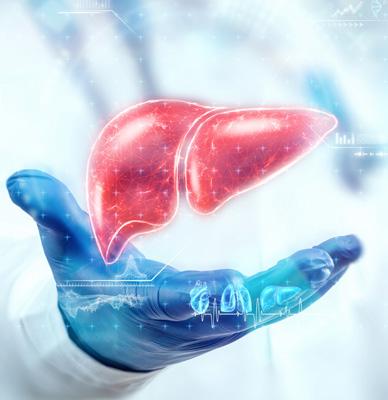
As we age, the body’s natural ability to counteract reactive molecules, including free radicals and other oxygen-containing molecules, diminishes significantly. This decline contributes to higher levels of oxidative stress, associated with systemic inflammation and a spectrum of chronic illnesses and age-related problems. Consuming antioxidantrich substances through diet, supplements, or nutraceuticals can assist the body in managing the oxidative stress commonly linked with aging.
“Previous studies have demonstrated that citrus flavonoids possess protective capabilities against oxidative stress, effectively supporting a healthy inflammatory response,” said Dr. Thais Cesar, lead researcher and scientific advisor to Ingredients by Nature. “Eriomin has exhibited antioxidant and anti-inflammatory activity in both young and adult animals and humans. Inflammation linked to the aging process (inflammaging) is damaging and a major risk factor and marker for serious age-related conditions. Longevity is an exciting and rapidly growing area for nutraceuticals, and as such, we wanted to assess Eriomin’s effectiveness in the aging process.”
This published study explored hepatic redox regulation in elderly rats after four weeks of Eriomin administration. The study evaluated the impact of Eriomin supplementation on the liver, a highly susceptible organ to the oxidative processes of aging. Biochemical and molecular tests were conducted to assess Eriomin’s potential in regulating hepatic redox activity and hepatic protein persulfidation levels.
The study results revealed that Eriomin enhanced the activity of hepatic antioxidant enzymes, including glutathione peroxidase (GPx), glutathione reduc-
tase (GR), and catalytic glutamate-cysteine ligase. Furthermore, Eriomin treatment increased the activity of the nuclear transcription factor Nrf2, a key player in cellular defense against oxidative stress and the maintenance of redox homeostasis. These findings highlighted Eriomin’s ability to modulate hepatic redox regulators Nrf2 and Trx1 (thioredoxin 1), alleviate oxidative stress, and reduce persulfidation levels, suggesting a substantial and beneficial antioxidant potential of lemon flavanones in aging livers.
“This pioneering study provides new insights into the positive impact of Eriomin on the hepatic redox environment, further positioning Eriomin as a promising approach for potent antioxidant and inflammatory support,” said Rob Brewster, president at Ingredients by Nature. “Eriomin is already patented for boosting GLP-1 levels (Glucagon-Like Peptide-1). GLP is known for its role in the body’s natural glucose absorption and feeling of satiety, and it is the key mechanism of action behind several blockbuster pharmaceuticals. We are thrilled with the outcomes of this study and plan to conduct further investigation into Eriomin’s impact on the aging body.”
Eriomin is a high-potency proprietary lemon flavonoid blend primarily composed of Eriocitrin, a flavonoid naturally found in lemons and oranges. Eriomin is also clinically validated to aid in maintaining healthy blood glucose levels, supporting normal insulin sensitivity, boosting glucagon-like peptide-1 (GLP-1), and supporting a healthy prediabetic microbiota.
To learn more about the clinically backed, patented citrus flavonoid extract, Eriomin®, visit: IngredientsByNature.com or stop by their booth at the upcoming Natural Products Expo West, booth# 4652.

Introduction to Food Supplement Development
The food supplement industry has experienced significant growth due to increasing consumer focus on health and wellness. New product development is crucial for companies to stay competitive, innovate, and meet evolving consumer needs.
AUTHOR: Daria Šurić, MPharmOverview of the food supplement industry
The food supplement industry has witnessed remarkable growth and evolution in recent years. With an increasing focus on health and wellness, consumers are actively seeking ways to enhance their wellbeing and address specific health concerns. This has created a significant demand for food supplements, resulting in a thriving market that offers immense opportunities for B2B food supplement producers, CMOs, and brand owners. Understanding the dynamics of this industry is crucial for those involved in new product development for food supplements.
In addition to consumer demand, the food supplement industry is influenced by various regulatory frameworks and guidelines. B2B food supplement producers, CMOs, and brand owners need to stay updated on these regulations to ensure compliance and maintain the quality and safety of their products
The food supplement industry offers immense potential for B2B food supplement producers, CMOs, and brand owners.
Importance of new product development
In the highly competitive landscape of the food supplement industry, staying ahead of the curve is essential for B2B food supplement producers, CMOs,
and brand owners. One of the key ways to achieve this is through effective new product development.
New product development is crucial for several reasons. Firstly, it allows businesses to stay relevant and meet the ever-changing needs and demands of consumers. By investing in new product development, food supplement producers can introduce innovative formulations that cater to the latest trends and consumer preferences. This not only attracts new customers but also helps retain existing ones who are looking for cutting-edge products.
Secondly, new product development provides opportunities for differentiation and competitive advantage. In a crowded marketplace, where numerous brands offer similar products, standing out becomes essential. By continuously developing new products, businesses can create a unique selling proposition that sets them apart from competitors. This could be through the introduction of novel ingredients, innovative delivery systems, or addressing specific health concerns that have not been adequately targeted by existing products. Such differentiation can lead to increased market share and profitability.
Thirdly, new product development allows for product line extensions and diversification. Expanding the product portfolio enables businesses to cater to a wider range of consumer preferences and needs. It also helps in reducing the risk associated with relying solely on a single product. By offering a variety
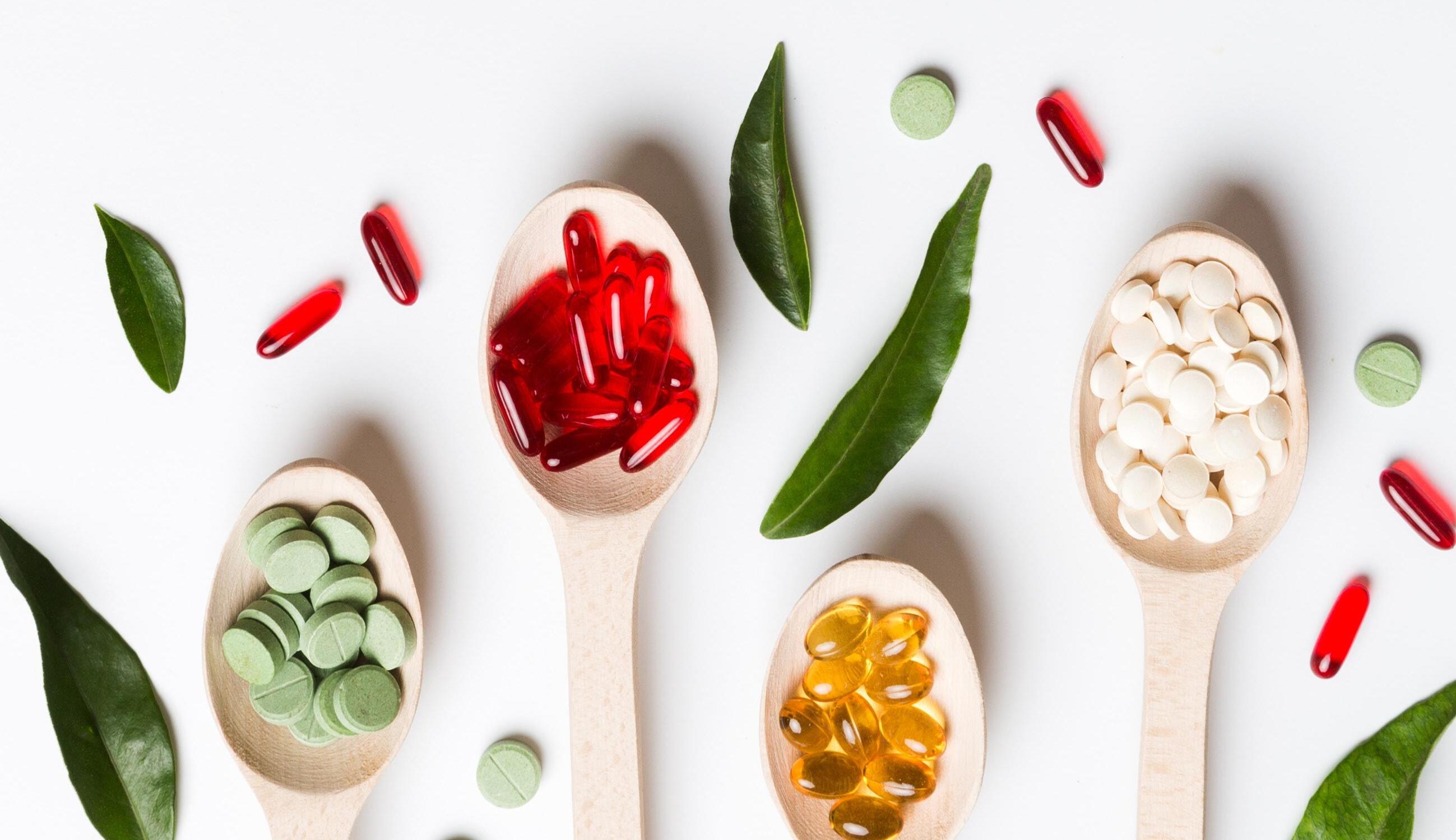

of food supplements, companies can capture different market segments and maximize their revenue potential.
Moreover, new product development is essential for maintaining relevance and compliance with regulatory requirements. As the regulatory landscape for food supplements is constantly evolving, businesses must develop products that meet the latest safety and labelling standards. Failing to keep up with these changes can result in legal issues, damage to brand reputation, and loss of market share.
In conclusion, new product development plays a vital role in the success of B2B food supplement producers, CMOs, and brand owners. It enables businesses to stay relevant, differentiate themselves from competitors, expand their product lines, and comply with regulatory requirements. By investing in new product development, companies can ensure long-term growth, profitability, and customer satisfaction in the dynamic and ever-evolving food supplement industry.
Understanding the target audience
In the fast-paced world of food supplement development, B2B food supplement producers, CMOs, and brand owners need to have a deep understanding of their target audience.
The target audience is the group of individuals or businesses that are most likely to purchase and use the food supplements being developed. These individuals may have specific dietary needs, health concerns, or lifestyle preferences that make them ideal candidates for the product. By understanding their needs, desires, and preferences, companies can create products that resonate with their target audience, leading to increased sales and customer satisfaction.
One of the first steps in understanding the target audience is conducting market research. This involves gathering information about the demographics, psychographics, and buying behaviours of potential customers. Demographic information includes age, gender, income level, and geographic location, while psychographic information delves into their interests, values, attitudes, and motivations. By analyzing this data, companies can gain invaluable insights into their target audience's preferences and tailor their product development accordingly.
Another important aspect of understanding the target audience is identifying their pain points and unmet needs. By conducting surveys, interviews, or focus groups, companies can gain a deeper understanding of the challenges and frustrations that their audience faces. This information can then be used to develop innovative solutions that address these pain points, setting the product apart from competitors and creating a unique selling proposition.
Additionally, understanding the target audience allows for effective marketing and communication strategies. By knowing their preferred communication channels, language, and messaging, companies can create targeted marketing campaigns that resonate with their audience. This ensures that the right message reaches the right people, increasing the chances of product adoption and customer loyalty.
Market research and analysis
Identifying market trends and demands
Staying ahead of market trends and demands is crucial for success. As a B2B food supplement producer, CMO, or brand owner, understanding the everevolving consumer preferences and emerging market opportunities is essential for new product development.
The first step in identifying market trends and demands is to conduct comprehensive market research. This involves analysing consumer behaviour, preferences, and purchasing patterns. By studying market reports, conducting surveys, and analyzing social media trends, you can gain valuable insights into emerging consumer needs and preferences. This information will serve as the foundation for your new product development strategy.
Understanding the niches within the food supplement industry is equally important. Each niche has unique characteristics and demands that require specific attention. Whether it's sports nutrition, weight management, or immunity boosters, comprehending the nuances of each niche will enable you to tailor your product development efforts accordingly.
Moreover, keeping an eye on the latest scientific research and breakthroughs is vital. The food supplement industry is driven by innovation and advancements in scientific knowledge. By staying up-to-date with the latest research, you can identify new ingredients, formulations, and delivery methods that align with consumer demands and market trends.
Lastly, understanding the regulatory landscape is crucial for navigating the food supplement market. With ever-changing regulations and guidelines, it is essential to stay compliant while developing new products. This subchapter will equip you with the necessary knowledge to ensure your products meet all regulatory requirements, thereby minimizing risks and maximizing market opportunities.
In conclusion, identifying market trends and demands is a vital aspect of mastering food supplement development. By conducting thorough market research, understanding niche markets, staying informed about scientific advancements, and complying with regulations, you can position yourself as a leader in the industry.
Conducting competitor analysis
Staying ahead of the competition is essential for success. To achieve this, B2B food supplement producers, CMOs, and brand owners must have a thorough understanding of their competitors and the market landscape they operate in. This is where conducting a comprehensive competitor analysis becomes crucial.
Competitor analysis involves evaluating the strengths and weaknesses of current and potential competitors to identify opportunities and improve business strategies. It provides valuable insights into market trends, competitor positioning, and potential threats, enabling businesses to make informed decisions and gain a competitive edge.
To conduct an effective competitor analysis, start by identifying your direct and indirect competitors. Direct competitors are those offering similar food supplement products to the same target audience,
WE CREATE VALUE
Fine Foods develops and manufactures contract products for the pharmaceutical, nutraceutical and cosmetics industries.

COMMITTED TO YOUR EXCELLENCE

while indirect competitors are those catering to the same target audience with different product offerings. Once identified, gather information on their product range, pricing strategies, distribution channels, marketing tactics, and customer feedback.
One of the most important aspects of competitor analysis is understanding your competitors' unique selling propositions (USPs) and how they differentiate themselves in the market. This involves analysing their product features, quality, packaging, and branding. By understanding what makes your competitors stand out, you can identify gaps in the market that your product can fill or areas where you can improve upon existing offerings.
Additionally, examining your competitors' marketing strategies can provide valuable insights into their target audience, messaging, and promotional activities. This information can help you refine your marketing efforts and create campaigns that effectively resonate with your target customers.
Furthermore, it is essential to keep a close eye on industry trends and emerging competitors. By monitoring new product launches, partnerships, and market developments, you can proactively adapt your business strategies and stay ahead of the competition.
In conclusion, conducting a competitor analysis is a critical step in the new product development journey for food supplement producers. By evaluating your competitors' strengths, weaknesses, and market positioning, you can identify opportunities and refine your strategies to gain a competitive advantage. Stay informed, stay ahead, and master the art of conducting competitor analysis to succeed in the dynamic world of food supplement development.
Assessing regulatory requirements and restrictions
B2B food supplement producers, CMOs, and brand owners must have a solid understanding of the regulatory landscape.
Before diving into the intricacies of regulatory compliance, it is essential to highlight the importance of adhering to these requirements. Failure to comply with regulations can lead to severe consequences, including product recalls, fines, and damage to your brand's reputation. Therefore, a proactive approach to understanding and meeting regulatory obligations is critical for smooth market entry and sustained success.
By thoroughly assessing regulatory requirements and restrictions, B2B food supplement producers, CMOs, and brand owners can mitigate risks, ensure compliance, and streamline the development and launch of their new products.
Ideation and concept generation
Brainstorming techniques for product ideas
One of the most effective ways to gain a competitive edge is through the generation of innovative product ideas. This subchapter aims to provide valuable insights into effective brainstorming techniques that can fuel the new product development process for food supplements.
1. Mind mapping: This technique involves creating a visual representation of ideas, allowing for the exploration of various concepts and their relation-
ships. Start with a central theme, such as a specific target audience or health benefit, and branch out with related ideas.
2. Reverse ideation: Instead of focusing on generating new ideas, reverse ideation challenges individuals to identify potential problems or pain points faced by consumers. By understanding these challenges, you can create innovative solutions that address specific needs in the market.
3. Crowdsourcing: Engaging with a diverse group of individuals, such as employees, customers, or industry experts, can provide a wealth of ideas. Utilize online platforms, social media, or dedicated brainstorming sessions to gather insights and perspectives from different stakeholders.
4. Analogous thinking: Look beyond the food supplement industry and draw inspiration from other sectors. Identify successful products or concepts that align with your goals and find ways to adapt those ideas into the food supplement context.
5. Mind dumping: Set a time limit and challenge yourself to write down as many ideas as possible without analyzing or filtering them. This technique encourages free-flowing creativity, helping to overcome mental blocks and stimulate new connections.
6. Trend analysis: Stay up-to-date with the latest trends and consumer preferences in the food supplement market. Study market reports, consumer surveys, and competitor analysis to identify emerging trends and potential gaps in the market.
Remember, effective brainstorming is not just about generating ideas but also about evaluating and refining them. Once a pool of ideas is generated, prioritize them based on feasibility, market demand, and alignment with your brand's vision. Collaboration with cross-functional teams can also enhance the brainstorming process by bringing together diverse perspectives and expertise.
By leveraging these brainstorming techniques, B2B food supplement producers, CMOs, and brand owners can unlock a world of innovative product ideas. Through continuous exploration and refinement, you can create unique and impactful food supplement offerings that resonate with consumers and drive business growth.
Evaluating the feasibility and profitability of concepts
Bringing a new concept to market involves numerous challenges and risks.
Feasibility assessment is the first crucial step in the product development process. It involves evaluating the technical, financial, and operational aspects of a concept to determine if it is viable. This evaluation should consider factors such as ingredient availability, manufacturing capabilities, regulatory compliance, and potential intellectual property issues. By conducting a comprehensive feasibility study, businesses can identify any potential roadblocks or limitations early on, saving both time and resources.
Once a concept is deemed feasible, the next step is to evaluate its profitability. This assessment involves analyzing market trends, customer needs, and the competitive landscape to determine the concept's potential demand and revenue generation. Conduc-

ting market research, surveys, and focus groups can provide valuable insights into consumer preferences, allowing businesses to tailor their concepts accordingly. Additionally, analyzing cost structures, pricing strategies, and potential sales volumes will help calculate the concept's profitability and return on investment.
To further enhance the evaluation process, it is important to benchmark the concept against existing products in the market. By comparing the concept's unique selling points, formulation, and pricing with similar products, businesses can identify any gaps or opportunities for differentiation. This analysis will enable them to position their concept strategically and understand its potential market acceptance.
Moreover, assessing the concept's compatibility with the brand's overall strategy and target audience is crucial. Aligning the concept with the brand's values and positioning will enhance its marketability and strengthen the brand's identity. Understanding the target audience's needs, preferences, and purchasing behaviors will facilitate the development of concepts that resonate with customers, increasing the chances of success.
In conclusion, evaluating the feasibility and profitability of concepts is a critical aspect of new product development for food supplement producers, CMOs, and brand owners. By conducting comprehensive feasibility studies, analyzing market trends, benchmarking against competitors, and aligning with the brand's strategy, businesses can make informed decisions and maximize their chances of bringing successful products to market. This evaluation process will mitigate risks, optimize resources, and ultimately lead to the creation of innovative and profitable food supplement concepts.
Creating a unique selling proposition (USP)
B2B food supplement producers, CMO-s, and brand owners must develop a unique selling proposition (USP) for their new products. A USP is a key factor that sets a product apart from its competitors and helps to attract and retain customers
Why is a USP important in the food supplement in-
dustry? With numerous companies offering similar products, having a USP is vital to differentiate your brand and capture the attention of potential customers. A well-defined USP not only helps to establish a clear brand identity but also drives sales and fosters customer loyalty. It enables you to communicate the unique benefits and advantages of your product, giving you a competitive edge in the market.
To create a compelling USP, it is essential to understand your target audience and their specific needs and desires. Conduct thorough market research to identify the gaps in the market and assess the competition. This analysis will help you uncover opportunities to position your product uniquely and cater to unmet consumer demands.
Once you have gathered relevant information, focus on identifying the key benefits that your product offers. Highlight the attributes that make it stand out, such as superior quality, innovative formulation, sustainable sourcing, or specialized targeting of specific health concerns. Emphasize how these features translate into tangible benefits for the end consumer, whether it is improved well-being, increased energy levels, or enhanced performance.
Crafting a USP also involves effectively communicating your brand's story and values. Consumers are increasingly seeking products that align with their values and beliefs. Therefore, emphasize any ethical or sustainable practices your brand follows, ensuring that your USP resonates with your target audience on a deeper level.
Furthermore, a successful USP should be clear, concise, and easily understood. Avoid using technical jargon or complex language that might confuse or alienate potential customers. Instead, strive for simplicity and clarity, ensuring that your messaging is compelling and memorable.
Creating a unique selling proposition is essential for B2B food supplement producers, CMO-s, and brand owners involved in new product development. A well-crafted USP differentiates your product from the competition, attracts customers, and fosters brand loyalty. By understanding your target audience, identifying key benefits, and effectively communicating your brand's story, you can develop a compelling USP that sets your food supplement apart and captivates the market.
Impact of MKARE® on Tendons and Flexibility
Nutrients like collagen and vitamin C support tendon elasticity, while physical exercise stimulates collagen synthesis. MKARE®, a natural eggshell membrane supplement rich in essential biomolecules like collagen, elastin, and glycosaminoglycans, has been clinically proven to enhance tendon strength and protect against joint issues by reducing inflammation and improving collagen quality, as demonstrated in studies involving athletes.
Tendons are dense connective tissues, primarily composed of collagen and elastin. Between 60% and 85% of the dry weight of the tendon is collagen. This collagen is predominantly type I (~60%), arranged in tension-resistant fibers. Elastin fibers represent approximately 2% of the dry weight.
Various nutrients, such as collagen and vitamin C, can help maintain the elasticity and strength of tendons. A diet rich in these types of nutrients contributes to preserving tendon elasticity.
Less flexible tendons may result in joint pain or osteoarthritis (OA), highlighting the critical importance of maintaining tendon health.
Interestingly, collagen synthesis rises around 100% in human tendon, after just one bout (60 min) of acute exercise. The elevated collagen synthesis is still present 3 days after exercise. Therefore, it is very important to do physical exercise to stimulate collagen synthesis in the tendons and, at the same time, have an oral consume of supplements that help to nourish the tissues. MKARE® is a potent alternativeas a nutritional supplementto support tendons.
MKARE® is a branded ingredient based on 100% natural eggshell membrane, this multi-functional ingredient naturally contains a complex source of key bio-
active compounds that has more than one purpose.
The clinically proven MKARE® is abundant in collagen types I, V, and X, hyaluronic acid, elastin, chondroitin sulfate, glucosamine, and more than 400 proteins. It stands as a distinctive solution, delivering a myriad of benefits in a single.
MKARE® enhances tendon strength
MKARE® contains the identical biomolecules found in the extracellular matrix of tendons (collagen, elastin, and glycosaminoglycans), and it is also rich in lysyl oxidase, which is crucial for stabilizing collagen and elastin fibers. This composition provides essential nutrients to our cells, reinforcing the structure of tendons and the musculoskeletal system.
There is an example of a study that validates the protective effect on the tendon in a group of athletes treated with oral consumption of eggshell membrane. The research highlights the membrane's ability to protect the tendon structure through oral consumption of egg membrane. This effect is attributed to the improvement in collagen quality and an increase in the tendon cross-section when consuming egg membrane.
The study involved administering egg membrane

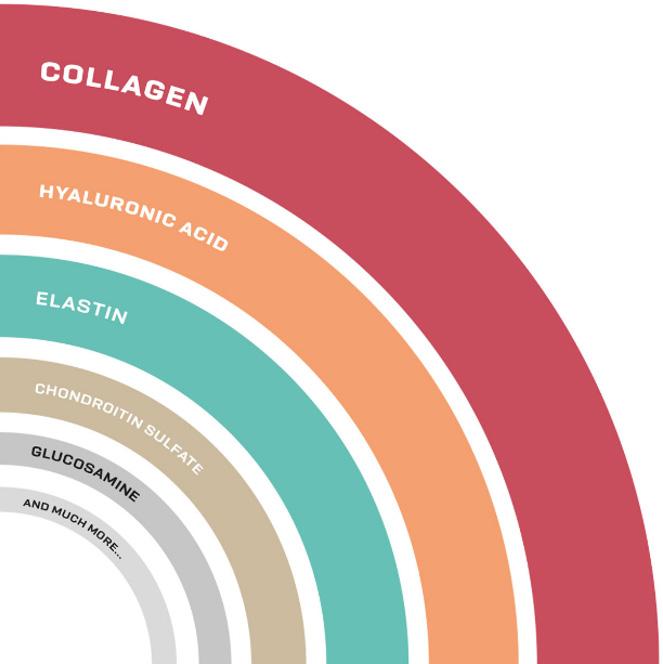
to 22 athletes with joint problems for a period of 50 days. The results underscore that the "linear stiffness" of the Achilles Tendon (AT)*, measured as a biomechanical parameter, maintains its values in the group treated with eggshell membrane (0.6 N/mm ± 0.3 to 0.6 N/mm ± 0.2). In contrast, the placebo group experiences a notable decrease (0.8 N/mm ± 0.3 to 0.5 N/mm ± 0.1) (37.5%), highlighting the membrane's ability to protect athletes' tendons.
The linear stiffness test is a biomechanical assessment that directly measures tendon strengthening and evaluates the joint's ability to absorb substantial impacts.
Reducing inflammatory issues in the joints enhances their flexibility. Thanks to various molecules with this effect contained in the membrane, such as ovotransferrin and ovocalyxin-36, have been proven to possess powerful anti-inflammatory properties. Even fragments of these molecules have demonstrated an enhanced anti-inflammatory effect. MKARE® has shown to reduce proinflammatory cytokines in a cellular model, thus demonstrating its mechanism of action.
References:
1 Kjaer, Michael "Role of extracellular matrix in adaptation of tendon and skeletal muscle to mechanical loading." Physiological reviews 84.2 (2004): 649-698.
2 Praet S et al. “Oral Supplementation of Specific Collagen Peptides Combined with Calf-Strengthening Exercises Enhances Function and Reduces Pain in Achilles Tendinopathy Patients.” Nutrients. 2019;11(1):76.
3 6 DePhillipo N et al. “E"icacy of Vitamin C Supplementation on Collagen Synthesis and Oxidative Stress A#er Musculoskeletal Injuries: A Systematic Review.” Orthop J Sports Med. 2018;6(10): 2325967118804544.
4 Maganaris CN, Paul JP (1999) In vivo human tendon mechanical properties. J Physiol 521: 307-313.
5 Kjær, Michael et al. "Extracellular matrix adaptation of tendon and skeletal muscle to exercise." Journal of anatomy 208.4 (2006): 445-450.
6 Aguirre A, Quintana EG, Fenaux M, Erdozain S, Nuez ML (2017) Effects of 50 Days Eggshell Membrane Ovomet® Supplementation on Biomechanics Parameters and Subjective Pain Perception Among Crossfit Athletes. A Preliminary Study. J Trauma Treat 6: 371.
7 Johnson GA, Tramaglini DM, Levine RE, Ohno K, Choi NY, et al. (1994) Tensile and viscoelastic properties of human patellar tendon. J Orthop Res 12: 796-803.
8 Baratta R, Solomonow M (1991) The effect of tendon viscoelastic stiffness on the dynamic performance of isometric muscle. J Biomech 24: 109-116
Pomella®’s New Research Supports Gut Health
Study results imply that consuming Pomella® pomegranate extract promotes a healthier gut and improves gut-body communication.
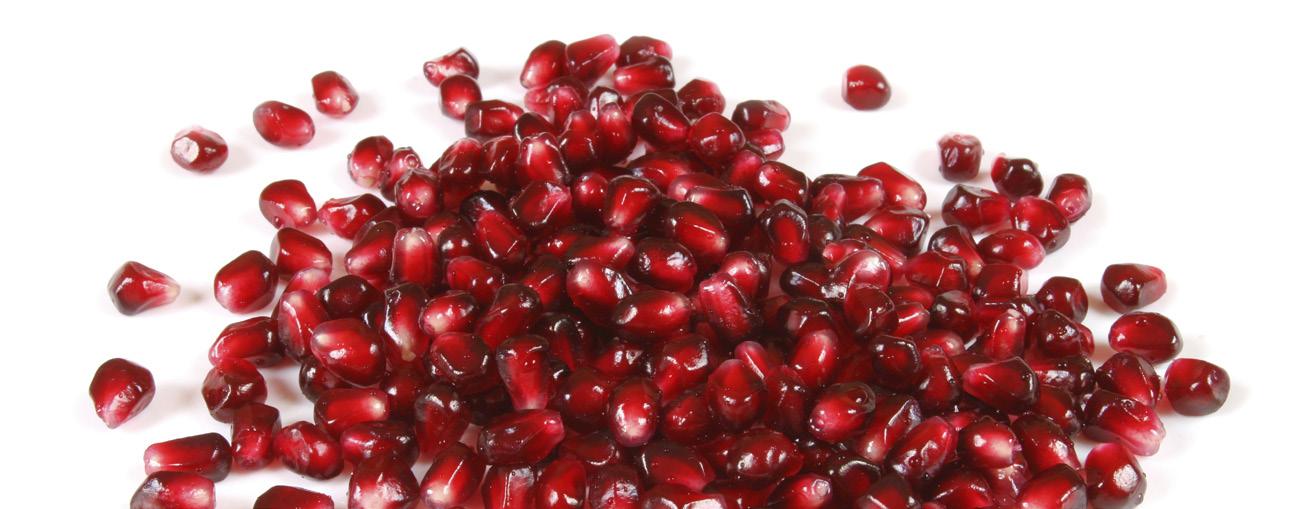
In a new four-week trial, 250mg/day of Pomella® pomegranate extract was tested on healthy adults aged 25-55 (n=18, predominantly women). The study aimed to assess its impact on the gut microbiome, circulating short-chain fatty acids, and urolithins, gut-microbial derived ellagitannin metabolites, using whole genome sequencing for microbial analysis.
The results revealed that gut functional analyses are consistent with circulating short-chain fatty acids (SCFAs), reinforcing the idea that Pomella® supplementation improves SCFA levels by influencing the gut microbiome. These results imply that consuming Pomella® pomegranate extract promotes a healthier gut and improves gut-body communication.1
Expanding on these findings, researchers highlighted significant changes in short-chain fatty acids (SCFAs) pre and post Pomella® extract supplementation. They observed a 162% rise in propionate levels (p = 0.02) and a 38% increase in acetate levels (p = 0.12) following Pomella® supplementation.1
Pomella® Pomegranate Extract is a breakthrough formula developed to deliver benefits through the antioxidant polyphenols, in particular ellagitannins, such as punicalagins and their gut-derived metabolites, urolithins. With its clean-label and plant-based composition, Pomella® provides scientifically researched antioxidant benefits suitable for diverse applications, ranging from promoting gut health, cardiovascular support, cognitive and recent findings have also show strong benefits of Pomella® to improving inner beauty through the gut-skin axis.
What are short chain fatty acids and why are they important? Short chain fatty acids can act as postbiotics, or the bioactive by-product of probiotics and prebiotics, in signalling from the gut to other areas of the body. In particular, butyrate, propionate, and acetate are key amino acids known to support the gut-body axes.
Book a meeting with the team at our Vitafoods 2024 Stand (D80).
To learn more about Pomella® and its benefits, visit: https://www.lehvoss-nutrition.com/ingredients/trade-marked-ingredients/ 333-pomella%C2%AE-natural-pomegranate-extract.html
Reference:
1 Sivamani RK et al. Prospective, randomized, double-blind, placebo-controlled study of a standardized oral pomegranate extract on the gut microbiome and short-chain fatty acids. Foods. 2023 Dec 19. 13(1): 15pgs. doi: 10.3390/foods13010015
Enhancing Musculoskeletal Health: Exploring Joint Support Through Supplements
Addressing musculoskeletal health challenges is crucial for overall well-being, with joint pain being a common issue. Food supplements containing ingredients like glucosamine, chondroitin, hyaluronic acid, Boswellia serrata extract, and bromelain offer promising relief and preservation of joint function. Sustainability in processes like bromelain extraction and innovative formulations such as microencapsulation further enhance their efficacy and long-term viability, highlighting the importance of a comprehensive approach to musculoskeletal wellness.
AUTHOR: Valerija Pandža, MPharmMusculoskeletal health encompasses the functionality of the body's locomotor system, comprising muscles, bones, joints, and surrounding connective tissues. Conditions affecting this system are often marked by persistent pain, reduced mobility, and impaired dexterity, thereby hindering individuals' ability to engage fully in work and societal activities. Pain originating from musculoskeletal structures represents the most prevalent form of non-cancer-related pain.
These conditions are pertinent across all stages of life, from childhood through old age, ranging from acute incidents like fractures and strains to chronic ailments such as primary low back pain and osteoarthritis. They encompass a variety of joint-related issues including osteoarthritis, rheumatoid arthritis, psoriatic arthritis, gout, and spondyloarthritis.
Furthermore, musculoskeletal conditions represent a significant portion of the global demand for rehabilitation services. Individuals affected by these
conditions also face an increased risk of developing mental health disorders.
Joint pain can severely impact the quality of life. Joints can incur damage through various means: surpassing their natural range of motion (e.g., causing an ACL tear in the knee), enduring repetitive stress or pressure on the surrounding areas (e.g., from repetitive movements, poor positioning, or excessive load on a shoulder joint), or undergoing gradual deterioration due to factors like ageing, disease, or genetic predispositions. The combination of these potential causes, often intertwined and intersecting, complicates the management of joint pain. Additionally, the intricate nature of joint tissue further adds to the challenge of addressing these issues effectively.
A food supplement's role in joint health is very important in terms of preventing joint damage and also to slow down degenerative and ageing processes in joints.

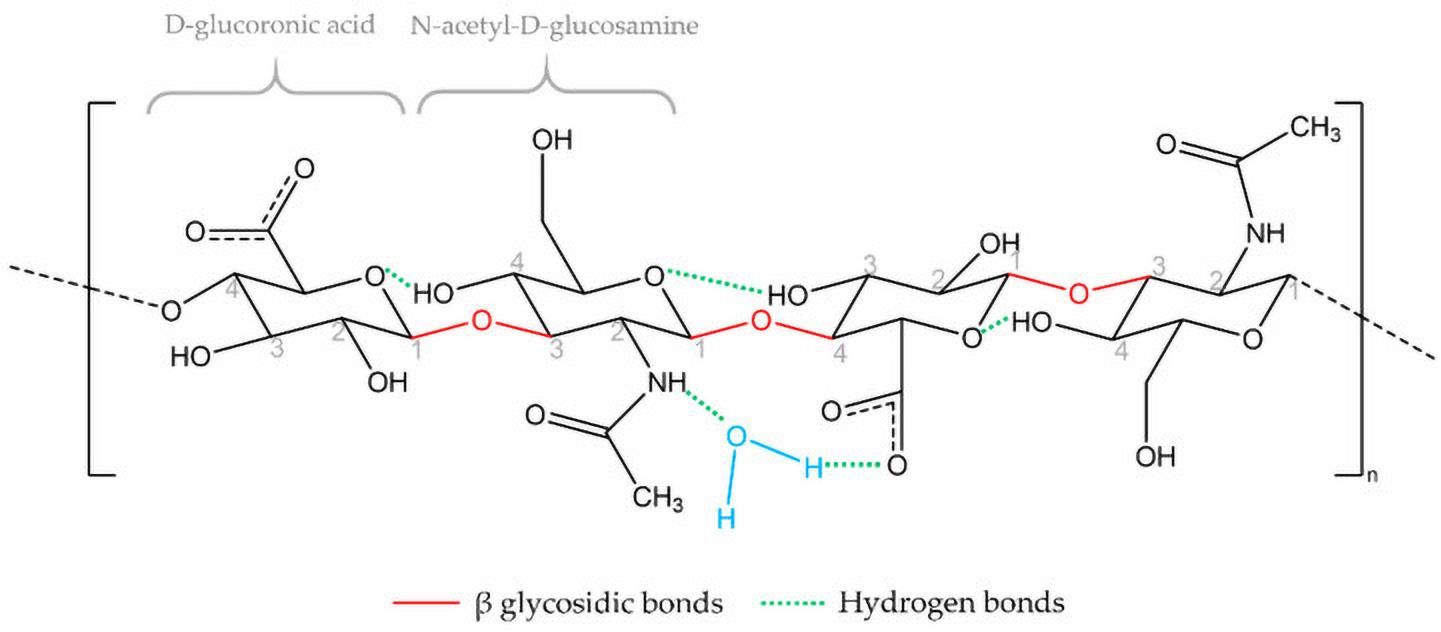
Adapted from: MarinhoA,NunesC,ReisS.HyaluronicAcid:AKeyIngredientintheTherapyofInflammation.Biomolecules. 2021;11(10):1518.Published2021Oct15.doi:10.3390/biom11101518
Joints are made of:
1. Articular cartilage: Smooth, slippery tissue covering the ends of bones within a joint, which helps reduce friction and allows for smooth movement.
2. Synovial membrane: A thin layer of tissue that lines the joint capsule and produces synovial fluid, which lubricates the joint and provides nutrients to the cartilage.
3. Joint capsule: A fibrous structure that surrounds the joint, consisting of tough connective tissue that helps hold the bones together and maintain joint stability.
4. Ligaments: Strong bands of fibrous tissue that connect bones to other bones, providing stability and limiting excessive movement in the joint.
5. Tendons: Fibrous cords of tissue that connect muscles to bones, transmitting forces generated by muscle contraction to move the joint.
6. Meniscus (in certain joints): Cartilaginous structures found in some joints, such as the knee, that act as shock absorbers and help distribute forces evenly across the joint surfaces.
Ingredients helping maintain healthy and functional articular cartilage
Supplements for joint health with a focus on articular cartilage often contain glucosamine, chondroitin, hyaluronic acid, Boswellia serrata extract, bromelain and many more.
Glycosaminoglycans (GAG-s)
The extracellular matrix (ECM) serves as a gel-like substance occupying the intercellular spaces within tissues, facilitating cell cohesion and serving as a conduit for the diffusion of vital nutrients and oxygen to individual cells. Comprised of fibrous proteins such as collagen, elastin, fibronectin, and laminin, as well as heteropolysaccharides known as glycosaminoglycans (GAGs), the ECM forms a complex network essential for tissue structure and function.
Chondroitin, classified as a glycosaminoglycan, comprises elongated polysaccharide chains characterized by a repeating disaccharide pattern. Typical-
ly consumed in the form of chondroitin sulfate supplements, it occurs naturally within cartilage. In this tissue, chondroitin plays a pivotal role in thwarting tissue degradation and furnishing vital mechanical reinforcement to the joints.
Chondroitin is frequently employed to mitigate the symptoms associated with osteoarthritis, often in conjunction with glucosamine. Among individuals afflicted with osteoarthritis, chondroitin supplementation has been observed to potentially alleviate pain and joint stiffness, as well as potentially impede the advancement of the condition1
Dosage recommendations range from 800 mg–1200 mg per day. This may be taken as a single dose or in 2–3 400mg doses.
Glucosamine sulfate has studies that prove its effect on pain.
Glucosamine sulphate is usually dosed up to 1500 mg in medicinal products but also, in food supplements. One of the limiting factors in formulating glucosamine is dosage, if you want to achieve 1,5 g of the mentioned daily dosage.
Usually, it is recommended to be in powder form in sachets since otherwise 4 tablets per day are a bad choice in terms of compliance for food supplement users.
Hyaluronic acid (HA) is a large mucopolysaccharide that is found naturally throughout the body and in high concentrations in the skin, the joint fluid, and the eye. (Figure 1) It is produced from animal sources or by bacterial fermentation.
In its native form, HA appears as a very long polymer, called high-molecular weight HA (HMWHA)]. However, under certain conditions, the molecule can be broken down into small fragments, called low-molecular weight HA (LMWHA). HMWHA, usually greater than 1000 kDa, is present in intact tissues and is antiangiogenic and immunosuppressive, while smaller polymers indicate signs of distress and are potent inducers of inflammation and angiogenesis. Most cells in the human body can synthesize HA during certain processes in their cell cycle.
HA differs from other GAGs because it is not sul-
phated and is not synthesised by Golgi enzymes in association with proteins; it is produced in the inner face of the plasma membrane, without any covalent binding to a protein nucleus, by hyaluronan synthases (HAS-1, HAS -2 and HAS-3). These three proteins place the HA molecules in the extracellular space through pore-like structures, along the length of the polymeric chain, repeatedly adding D-glucuronic acid and N-acetyl-D-glucosamine (Figure 2), giving rise to molecules of different sizes. This unique synthesis mechanism, which allows the molecule to be secreted during its production, is essential; otherwise, due to its enormous size, the cells would be destroyed. Incorrect deregulation of the expression of HAS genes results in abnormal HA production and, therefore, an increased risk of pathological events, altered cellular responses to injuries and aberrant biological processes. It has also been established that growth factors, such as epidermal growth factor (EGF) or keratinocyte factor, increase the rate of HA synthesis.
Due to its molecular structure at a neutral pH, HA attracts water molecules and can contain up to 10,000 times its weight in water. The viscous gel formed by the HA matrices lubricates the joints and acts as a buffer for the surrounding tissues, as well as participating in tissue regeneration and remodelling processes, for example, during the healing process2
For oral supplementation, the recommended dosage is 120 mg per day, with supplements usually available in either 60 mg or 120 mg tablets.
Frankincense Boswellia serrata
Derived from the Boswellia serrata tree, gum resin has long been recognized for its potential in promoting joint health. Its active compounds, including boswellic acids, possess anti-inflammatory properties that can help alleviate symptoms associated with conditions like osteoarthritis and rheumatoid arthritis. Research suggests that Boswellia extracts may reduce pain, stiffness, and inflammation in joints, enhancing mobility and overall quality of life for individuals with joint-related issues. Incorporating Boswellia supplements as part of a comprehensive approach to joint care may offer significant benefits, providing a natural and alternative option for managing joint discomfort and promoting long-
term joint health.
The gum resin is extracted from a well-known herb Boswellia serrata Roxb. ex Colebr. (Family: Burseraceae), also called Indian frankincense or Salaiguggul , has been used in traditional Ayurvedic medicine in India for centuries as a remedy for the treatment of chronic inflammatory diseases, including OA.
The β-configured pentacyclic triterpene acids in B. serrata include 3-acetyl-11-keto-β-boswellic acid (AKBBA), 11-keto-β-boswellic acid (KBBA), β-boswellic acid (BBA), and 3-acetyl-β-boswellic acid (ABBA), representing major ingredients.
In following study, BSE tablets, each tablet containing the BSE extract of 169.33 mg with a mean value of 87.3 mg of total β-boswellic acids, corresponding to the four major β-boswellic acids, namely, AKBBA (53.27 mg), BBA (20.83 mg), KBBA (7.11 mg), and ABBA (6.06 mg), were given twice a day. Thus, the selected dosage of BSE, equivalent to 87.3 mg of total β-boswellic acids per tablet twice a day (174.6 mg of total β-boswellic acids per day), was safe.
A double-blind, placebo-controlled human trial was conducted to evaluate the safety and efficacy of a standardised oral supplementation of Boswellin®, a novel extract of Boswellia serrata extract (BSE) containing 3-acetyl-11-keto-β-boswellic acid (AKBBA) with β-boswellic acid (BBA). A total of 48 patients with osteoarthritis (OA) of the knee were randomized and allocated to the BSE and placebo groups for intervention. Patients were administered BSE or placebo for 120 days. The trial results revealed that BSE treatment significantly improved the physical function of the patients by reducing pain and stiffness compared with placebo. Radiographic assessments showed improved knee joint gap and reduced osteophytes (spur) confirming the efficacy of BSE treatment. BSE also significantly reduced the serum levels of highsensitive C-reactive protein, a potential inflammatory marker associated with OA of the knee. No serious adverse events were reported. This is the first study with BSE conducted for 120 days, longer than any other previous clinical trial on patients with OA of the knee. The findings provide evidence that biologically active constituents of BSE, namely, AKBBA and BBA, act synergistically to exert anti-inflammatory/antiarthritic activity showing improvement in physical and functional ability and reducing pain and stiffness.
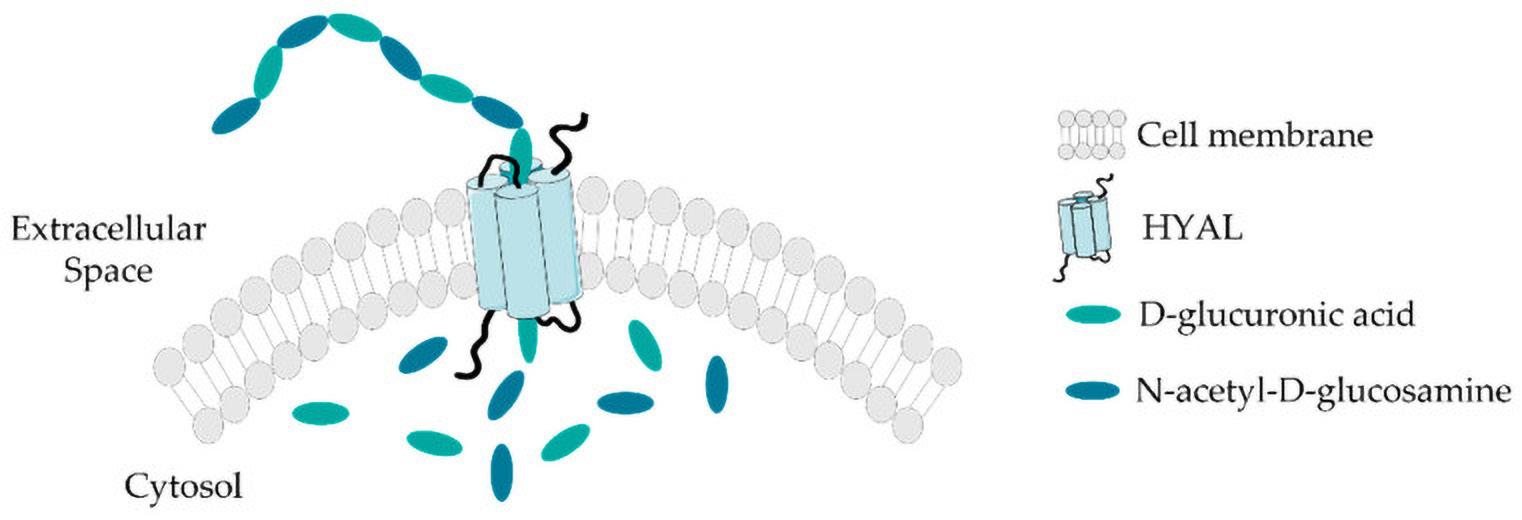
Examination of radiological X-ray images revealed reduced joint space due to loss of articular cartilage and osteophyte formation in OA of the knee patients in the placebo group. On the other hand, the OA of the knee patients in the BSE treatment groups showed significant improvements on the final visit (120 days). A distinct change in the OA condition could be seen where the gap between the knee joints increased significantly with a sharp decrease in osteophytes (spur) in subjects (Figure 3).
The present clinical trial demonstrated the safety and efficacy of oral supplementation of BSE containing 30% AKBBA and other bioactive β-boswellic acids, namely, BBA, KBBA, and ABBA, in newly diagnosed or untreated patients with OA of the knee.
Earlier, the efficacy of boswellic acid-containing product (Boswellin®) in combination with Curcumin C3 Complex® and ginger extract was demonstrated in the management of OA.
The current findings are also consistent with earlier studies indicating that BSE comprising β-configured derivatives of boswellic acids are specific
nonredox inhibitors of 5-LOX and hence inhibit leukotriene biosynthesis and reduce the pain associated with joint stiffness and physical discomfort.
This study has limitations- it is a pilot study with a small group of subjects. Despite some of these limitations, the present clinical trial demonstrated the safety and efficacy of BSE (Boswellin®), in patients with OA of the knee. Despite some of these limitations, the present clinical trial demonstrated the safety and efficacy of BSE (Boswellin®), in patients with OA of the knee. The findings from the present study provide clinical evidence to support that biologically active components of BSE, specifically AKBBA and BBA, acted synergistically to exert anti-inflammatory/anti-arthritic activity efficaciously in reducing joint pain and improving physical functional ability (Figure 4). No serious adverse events were observed, thus supporting the pharmacological safety of BSE (Boswellin®) to be considered a viable candidate for the treatment of OA of the knee3
Taking into account this study and other relevant studies, frankincense can be considered a very valu-

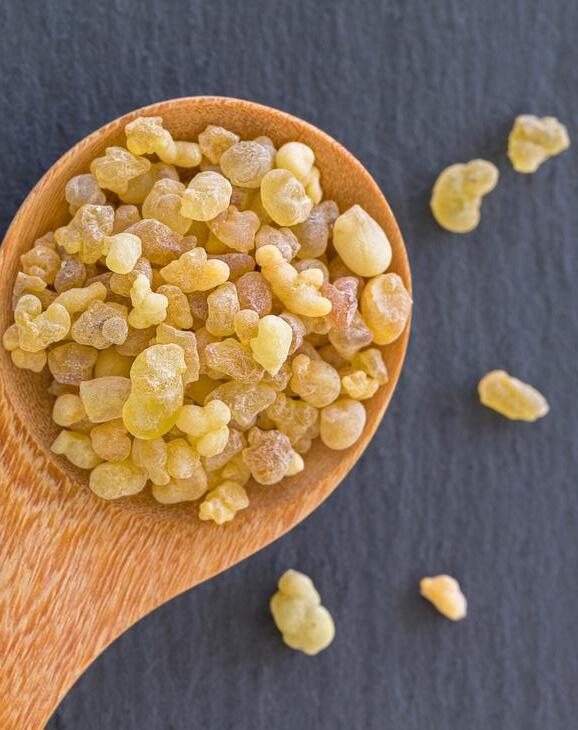
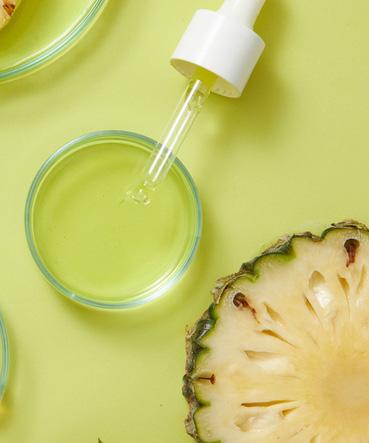
and 3-acetyl-11-keto-β-boswellic acid (AKBBA), act synergistically to exert anti-inflammatory/anti-arthritic activity to reduce joint pain and improve physical functional ability in patients with OA of the knee. ABBA: 3-acetyl-β-boswellic acid; IL: interleukin;
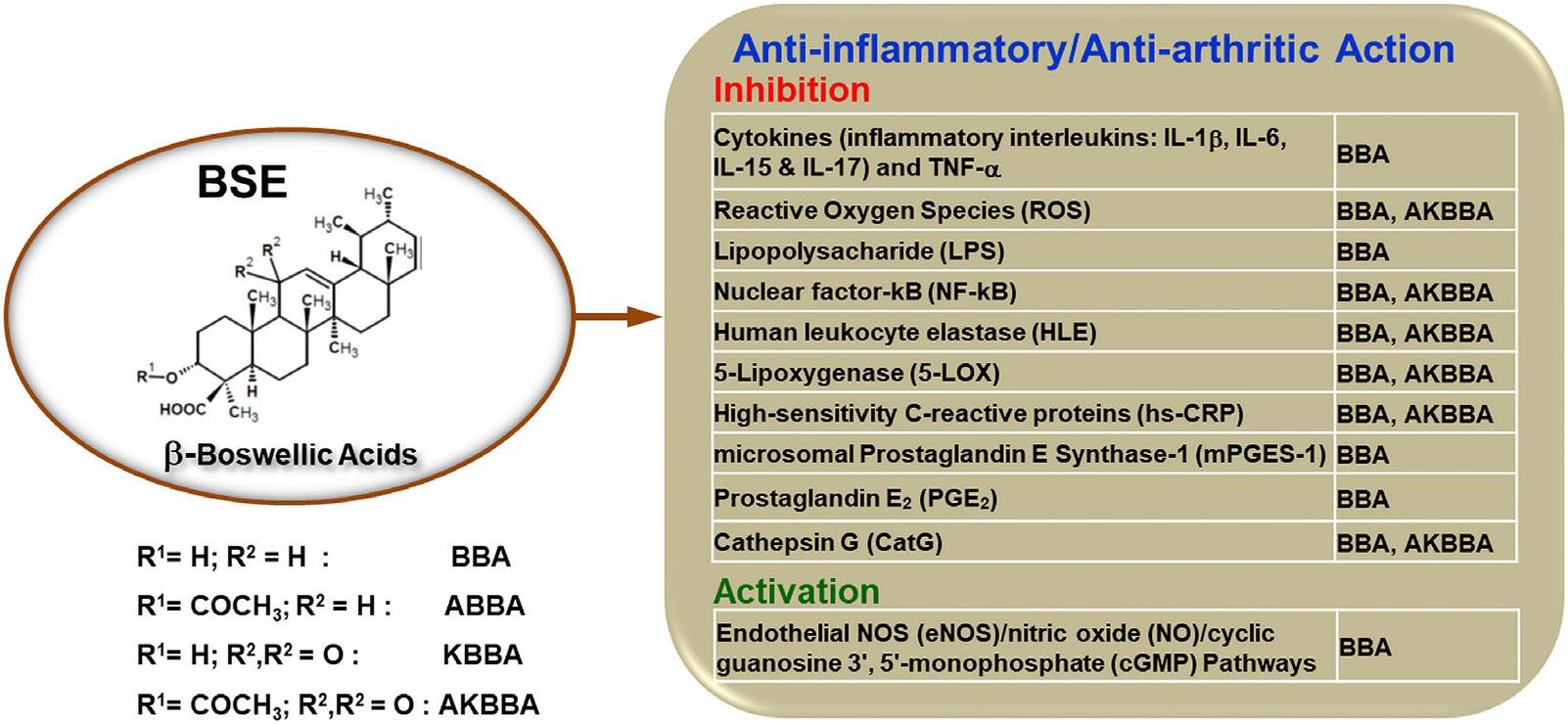
able asset in preserving joint function through different challenges (EFSA on hold claims in Table 1).
Bromelain
Bromelain is a mixture of proteolytic enzymes found in the pineapple plant (Ananas comosus). It is particularly concentrated in the stem and juice of the fruit. Bromelain has been used for centuries as a traditional medicine in Central and South America, where pineapples are native. Bromelain can be actively absorbed from the intestine and keep its bioactivity. Accurate quantification of bromelain enzymatic activity units, such as GDU and MCU, is essential for evaluating the potency and efficacy of bromelain-containing products. These standardized measurements facilitate informed decisions regarding supplement selection and dosage, particularly in therapeutic contexts where bromelain's proteolytic and anti-inflammatory properties are sought after.
Gelatin Digesting Units (GDU) represent the capacity of bromelain to hydrolyze gelatin under specific conditions. This measurement is crucial for assessing the enzyme's proteolytic activity. GDU activity of the extract is important for the dosage of the extract in the food supplement.
A following study demonstrated that bromelain effectively reduces mild acute knee pain and enhances overall well-being in a dosage-dependent manner among healthy adults. There is early clinical evidence supporting its potential in alleviating symptoms of osteoarthritis and rheumatoid arthritis.
This study aimed to explore bromelain's effects on mild acute knee pain lasting less than three months in otherwise healthy adults. Participants were randomly assigned either 200 mg or 400 mg of bromelain daily for one month and completed validated questionnaires assessing knee health and psycho-
logical well-being at the beginning and end of the intervention. Seventy-seven participants completed the study. Both treatment groups showed significant reductions in knee pain symptoms compared to baseline, with greater improvements observed in the high-dose group. Moreover, psychological wellbeing significantly improved in both groups, with a stronger effect seen in the high-dose group.
These findings suggest that bromelain may effectively alleviate physical symptoms and enhance overall well-being in individuals experiencing mild knee pain, with its efficacy potentially increasing with higher doses. Future research involving double-blind, placebo-controlled studies is needed to further validate these results4
Research suggests that some people may experience allergic reactions when using bromelain. People who are allergic to pineapple are particularly vulnerable5
Due to its good biological functions, lack of systemic cytotoxicity, and often excellent benefits that it offers, bromelain has been permanently used in many industries, such as cosmetology, pharmacy, food, and biotechnology. The commercial use of bromelain has contributed to the development of effective methods for extracting the enzyme from the pineapple stem, and the resulting preparations are characterized by ultra-purity. Pineapple stems are often considered food waste products, so their usage for bromelain extraction is very valuable.
Recent studies prove that using bromelain in combination therapy with other nutraceuticals, such as rutin, trypsin, or turmeric, results in significantly enhanced efficacy in the treatment of degenerative joint pain diseases6
Bromelain as a raw material for formulating food supplement products can be challenging. This is why
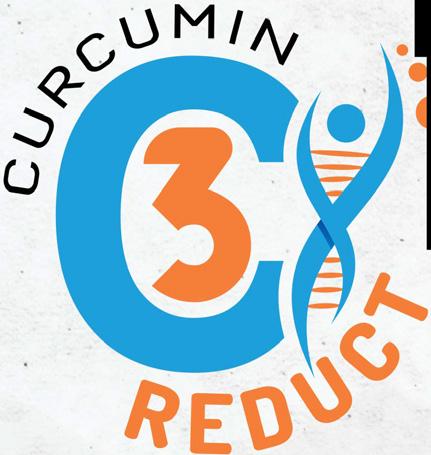
lnflamrnation in the body can result from physical or athletic exertion. And while a crucial and useful biologica I proces�, such chronic respon�es can damage tissue and cause injuries, leading to various conditions. Because it's composed exclusively of THC s - the major active metabolites of curcumin - C3 Reduct ® delivers anti-inflammatory properties that hold significant promises in protecting and soothing joints and muscles.






microencapsulation is recommended.
Microencapsulation of bromelain offers several advantages over its traditional powder form. One of the key benefits is improved stability. The microencapsulation process can enhance the stability of bromelain, protecting it from environmental factors such as heat, light, and oxygen that can degrade the enzyme. Another advantage is the potential for controlled release. Microencapsulation allows for the controlled release of bromelain, ensuring that it is delivered to the specific site in the digestive system where it can be most effective. This process can also improve the bioavailability of bromelain, increasing the amount that is absorbed into the body and thereby enhancing its effectiveness. Lastly, microencapsulation can mask the taste and odour of bromelain, making it more palatable. These advantages make microencapsulated bromelain a promising option for therapeutic applications.
Conclusion
In conclusion, the multifaceted nature of musculoskeletal health underscores the importance of proactive measures to address joint pain and maintain overall well-being. Incorporating supplements containing key ingredients like glucosamine, chondroitin, hyaluronic acid, Boswellia serrata extract, and bromelain can offer significant relief and support joint function. Furthermore, sustainable practices in extraction processes, such as those seen
with bromelain, alongside advancements like microencapsulation, not only enhance efficacy but also contribute to long-term viability and environmental stewardship. By incorporating targeted food supplements into everyday routine, patients can better navigate the complexities of musculoskeletal health and pave the way for improved quality of life.
References:
1 Bruyère O, Honvo G, Veronese N, et al. An updated algorithm recommendation for the management of knee osteoarthritis from the European Society for Clinical and Economic Aspects of Osteoporosis, Osteoarthritis and Musculoskeletal Diseases (ESCEO). Semin Arthritis Rheum. 2019;49(3):337-350. doi:10.1016/j.semarthrit.2019.04.008
2 Marinho A, Nunes C, Reis S. Hyaluronic Acid: A Key Ingredient in the Therapy of Inflammation. Biomolecules. 2021;11(10):1518. Published 2021 Oct 15. doi:10.3390/biom11101518
3 Majeed, Muhammed, et al. "A pilot, randomized, double‐blind, placebo‐controlled trial to assess the safety and efficacy of a novel Boswellia serrata extract in the management of osteoarthritis of the knee." Phytotherapy Research 33.5 (2019): 1457-1468.
4 Walker, A. F., Bundy, R., Hicks, S. M., & Middleton, R. W. (2002). Bromelain reduces mild acute knee pain and improves well-being in a dose-dependent fashion in an open study of otherwise healthy adults. Phytomedicine: international journal of phytotherapy and phytopharmacology, 9(8), 681–686. https://doi.org/10.1078/094471102321621269
5 Knox, S., Lang, D., & Hoyt, A. (2019). The many flavors of pineapple reactions. Annals of allergy, asthma & immunology : official publication of the American College of Allergy, Asthma, & Immunology, 123(5), 519–521. https://doi.org/10.1016/j.anai.2019.08.001
6 Hikisz, P., & Bernasinska-Slomczewska, J. (2021). Beneficial Properties of Bromelain. Nutrients, 13(12), 4313. https://doi.org/10.3390/ nu13124313
13-1 ID Wording Conditions
3699
EFSA Access Database:
Helps to maintain joint health/supports joint flexibility.
DGCCRF Excel Database (France):
Aide à maintenir la santé des articulations / soutient la souplesse des articulations.
Resin / The equivalent of 300-450 mg boswelic acids per day
3904
EFSA Access Database:
Supports joint flexibility/ Helps keep joints cool and comfortable.
DGCCRF Excel Database (France):
Prise en charge la flexibilité des articulations / aide à garder les articulations au frais et confortable.
2647
EFSA Access Database:
Boswellin might be supportive for the bone and joints health.
DGCCRF Excel Database (France):
Boswellia pourrait favoriser la santé des os et des articulations.
2648
EFSA Access Database:
Boswellin might have a beneficial role in musculoskeletal, bone and joints, and might be helpful for enhance effort of bone, joints and muscles.
DGCCRF Excel Database (France):
La boswelline pourrait avoir un rôle bénéfique dans l'appareil locomoteur, les os et les articulations, et pourrait être utile pour améliorer l'effort osseux, articulaire et musculaire.
4000 EFSA Access Database:
Helps keep joints cool and comfortable.
DGCCRF Excel Database (France):
Aide à garder les articulations fraîches et confortables.
Resin / 900-1200 mg of extract standardized 60% of boswellic acids daily / equivalent preparations
100-500 mg, consult with your doctor while pregnant or lactating
In the various human clinical studies the dosage of capsaicin from red pepper administered at 30 mg/day.
Resin powder: 1.00.05 g / day. All over 2 years old: 2-4 years ¼ adult dose, 4-10 years half adult dose
Study: Gencor’s Levagen®+ May Help Migraine Sufferers
Gencor has announced the publication of its recent human clinical trial demonstrating its palmitoylethanolamide (PEA) ingredient, Levagen®+, to be a safe and effective supplement for reducing discomfort and duration of migraines in healthy participants.
Migraines are a common neurological disorder affecting young to middle-aged adults and females more than males. Various treatment options are available; however, these can cause undesirable side effects. PEA has been clinically studied to support a healthy inflammatory response and its analgesic properties.
The double-blind, placebo-controlled clinical trial, published in the leading Pharmaceuticals journal, investigated the effectiveness of pain reduction, duration, and medication use during a migraine. Upon the commencing of migraine symptoms, study participants were either given 600mg of PEA (Levagen+) or a placebo (maltodextrin). Once the dose was taken, participants recorded a visual analog scale (VAS) for pain every 30 minutes for 4 hours or until the migraine resolved. If the migraine had not resolved 2 hours post-dose, study participants were instructed to take a second supplement.
The study demonstrated that Levagen+ resolved more headaches than the placebo after 2 and 8 hours. The Levagen+ participants also had a lower VAS for pain score at 1.5 and 4 hours and significant-
ly reduced rescue medication compared to the placebo.
“The results of this study further back PEA’s clinically validated benefits for its analgesic and inflammatory properties in addition to its neuroprotective effects,” said R.V. Venkatesh, Co-founder and Managing Director at Gencor. “We are thrilled about the promising results and potential of Levagen+ to support those who suffer from migraine.”
Levagen®+ is powered by LipiSperse® delivery technology developed by Pharmako Biotechnologies. It offers a functional and bioavailable form of palmitoylethanolamide (PEA) with superior absorption. Levagen+ is a self-affirmed GRAS ingredient manufactured in cGMP facilities and has been clinically tested to support joint health, sleep, recovery, immunity, discomforts, and inflammation. Levagen®+ is applicable for dietary supplements, food and beverages, and cosmeceuticals.
To review the published clinical data and for more information on Levagen+, visit www.levagenplus.com or GencorPacific.com.

Studies Deliver Scientific Evidence for Rhodiola rosea and Ashwagandha’s Stress-Reducing Properties
Review finds Rhodiola rosea improves stress-associated fatigue while Ashwagandha counteracts stress-related anxiety.

Areview of preclinical studies and human trials on adaptogens shows that Rhodiola rosea and Ashwagandha are both effective in combating stress.
Herbal adaptogens – specific botanicals historically used in traditional medicine – enhance the efficiency of the body’s adaptive response to physical, chemical or biological stressors. Rhodiola rosea (Golden root) and Ashwagandha (Withania somnifera or Indian ginseng) are classical plant adaptogens that promote stress resilience while counteracting stress-associated alterations such as anxiety, nervousness, irritability, insomnia and depression.
Botanical ingredients supplier Nektium and the University of Las Palmas de Gran Canaria in Spain evaluated both ingredients in a scientific review study for the European Journal of Medicinal Plants. Analysing existing in vitro , in vivo and clinical trials, they found that the overall evidence clearly indicates that both adaptogens have effective anti-stress activity.
Rhodiola rosea works by modulation of the central nervous system. In 2011, the European Medicines Agency’s herbal monograph on Rhodiola rosea approved its traditional use as an adaptogen for the temporary relief of symptoms associated with stress, such as fatigue, exhaustion and a general sensation of weakness. The decision was based on its longterm use in traditional medicine and numerous scientific studies.1
The new review study considered more than 70 human clinical trials on Rhodiola rosea , which were of varying quality in methodology, design and conditions. Despite these limitations, there was a clear level of evidence to demonstrate that Rhodiola rosea can effectively combat physical stress-related fatigue, low mood, anxiety, depression and may improve physical-mental working capacity.
Ashwagandha, meanwhile, could work by a similar or additional neuromodulatory mechanism. The clinical efficacy of its preparations and extracts has now been demonstrated across a large number of human trials. They support Ashwagandha’s potential therapeutic role as an adaptogenic anti-stress agent and in counteracting stress-related conditions, especially anxiety, nervousness and insomnia.
The review also assessed the evidence on the safety of both adaptogens. In April 2023, Denmark announced a ban on Ashwagandha after a risk assessment failed to establish a safe lower limit for intake. This study presents a favourable picture of Ashwagandha’s overall safety; however, it showed there is growing data concerning interactions with specific medications and potential adverse effects in susceptible individuals or those with certain health conditions or subclinical disorders.
The review found that Rhodiola rosea can be considered safe and is generally well tolerated in individuals with a wide variety of health statuses, al-


though caution is required when consuming Rhodiola rosea alongside psychotropic medication.
Rubén P. Machín, PhD, Project Manager – Research, Development & Innovation at Nektium, said: “Both adaptogens show effective anti-stress activity, but their specific mechanisms of action differ. Rhodiola rosea, with its impact on the central nervous system, demonstrates improvement in stress-induced fatigue, depression and enhanced mental and physical performance. Ashwagandha, on the other hand, exhibits serotonergic-dependent antidepressant effects and modulates GABAergic neurotransmission, potentially making it more effective against stressassociated anxiety, nervousness, and insomnia.”
He added: “Taking into account the endocrine mechanism of action and the most robust evidence of efficacy from clinical trials, Rhodiola rosea may tentatively be assigned as a regenerative ‘tonic vitalizing’ adaptogen, supporting stress-associated fatigue and weakness in several physical and psychological contexts. Ashwagandha could be considered as regenerative ‘tonic-nervine’ that counteracts stressrelated anxiety and insomnia or drowsiness.”
Bruno Berheide, Nektium’s Commercial & Partnership Director, said: “The review study suggests that the choice of adaptogen is important in relation to the desired use and target audience. For example, Rhodiola rosea could be recommended for morning intake due to its energising and vitalising effects, while Ashwagandha could be more suited for evening intake, due to its calming and sleep-promoting effects. Likewise, sports people could take advantage of Rhodiolaroseato combat fatigue and improve mental and physical performance, while Ashwagandha could be well positioned for individuals wishing to manage their anxiety levels in everyday life.”
Launched in 1997 by Nektium, Rhodiolife® was the world’s first standardised Rhodiola rosea extract to be made commercially available.
Laura López-Ríos, PhD, Head of Product Development – Research, Development & Innovation at Nektium, added: “Rhodiolife® is our premium adaptogen solution for use in health and nutrition products. It is standardised to the content of total rosavins and salidroside – the phytochemicals responsible for the adaptogenic anti-stress effects. Nektium has a rig-
orous, multi-step quality control program in place to ensure the authenticity and bioactives composition, providing reassurance about its ability to help combat physical and psychological stressors.”
Rhodiolife® recently received approval and a NPN (Natural Product Number) from Health Canada, which means several recommended health claims can be used:
As an adaptogen, to help to temporarily relieve symptoms of stress (such as mental fatigue and sensation of weakness)
• As an adaptogen, to help support cognitive function (such as mental focus and mental stamina)
• To help increase energy and resistance to stress (e.g. in case of mental and physical fatigue related to stress)
• A source of/provides antioxidants.
The full study, ‘Adaptogenic Botanicals with Emphasis on Rhodiola rosea and Withania somnifera’, can be viewed here: https://journalejmp.com/index. php/EJMP/article/view/1168/2339
About Nektium
Based on the island of Gran Canaria, Spain, Nektium specialises in the supply of branded and generic botanical ingredients of the highest quality. The business was born out of two friends’ shared passion for the phytochemistry and pharmacology of botanicals and their applications in health and wellness. When it was first established in 1997, little was known about many of these botanical extracts, but the team at Nektium made it their mission to explore and unleash their potential health benefits. Today, the company is still defined by this solid foundation of dedicated relationships and its love for nature and research. Nektium’s flagship products are Zynamite®, a proprietary mango leaf extract (Mangifera indica), Rhodiolife®, a rhodiola plant extract (Rhodiola rosea) as well as Xanthigen®, a proprietary botanical blend for weight management.
Reference:
1 European Medicines Agency. (2012). Committee on herbal medicinal products (HMPC). Assessment report on Rhodiola rosea L., rhizoma et radix. Document reference. EMA/HMPC/232100/2011
GC Rieber VivoMega™ to Launch EPA+DHA Algal Oil at Natural Products Expo West
GC Rieber VivoMega™ is announcing the launch of its premium VivoMega™ EPA+DHA Algae 2050 TGP Oils for the North American market at the Natural Products Expo West show in Anaheim, California.

Manufactured with award-winning water, its high-concentration vegan omega-3 from microalgae offers superior quality and purity with environmental and sustainable initiatives at the forefront.
“Adding EPA+DHA combination to our algae portfolio is a big win for us, our customers, partners, and the end consumer,” said Ståle Søfting, Sales and Marketing Director. “These EPA and DHA offerings provide a non-GMO, solvent-free, sustainable, and alternative source for these essential fatty acids. Additionally, as the supply and increased costs of fish oil remain top of mind for suppliers and manufacturers, algae concentrates offer a great alternative to support the demands of consumers wanting omega-3s.”
Many algae products in the market are refined or concentrates only available in EE form. VivoMega’s algae concentrate is 90% triglycerides (TG), which offers increased bioavailability for improved absorption in the body. It also comprises 73% long-chained omega-3 fatty acids and is Vegan certified.
By leveraging the company’s 120 years in the omega-3 industry, the GC Rieber Group has spearheaded the processing and purification of omega-3 concentrates for superior sensory and purity. Its SuperLight™ proprietary processing technology is designed and developed exclusively for algae oils. Its process utilizes high-end technologies, allowing for gentle and non-invasive processing with superior oxidation protection. This results in a product with
exceptional quality parameters and optimal resource utilization with little to zero waste.
The EPA+DHA algae is initially being launched in the US market, the world’s largest omega-3 ingredient market, with other markets to follow. GC Rieber VivoMega’s products are also SEDEX-certified and fully aligned with the EU Green Deal initiatives and the UN Global Compact guidelines.
GC Rieber VivoMega™ is a Norwegian leader of omega-3 solutions in an environmentally sustainable way. VivoMega aims to deliver the best quality omega-3 oil concentrates to customers globally. GC Rieber VivoMega utilizes state-of-the-art production equipment to produce some of the most potent, stable and pure omega-3 concentrates in the supplements market. The company has expanded its facility several times over the years, including the addition of a new industry-leading concentration production facility, delivering high grade DHA and EPA fish oils (up to 800mg/g) and now, a vegan Algae EPA +DHA omega 3 in addition to its algae DHA portfolio. As well as being a leader in omega-3 production, GC Rieber VivoMega is setting the benchmark for quality standards globally.
To learn more about VivoMega EPA and DHA Algae Oils, schedule a meeting with its team members at Natural Products Expo West by contacting: vivomega@gcrieber.com or visit Vivomega.com/products-algae/.
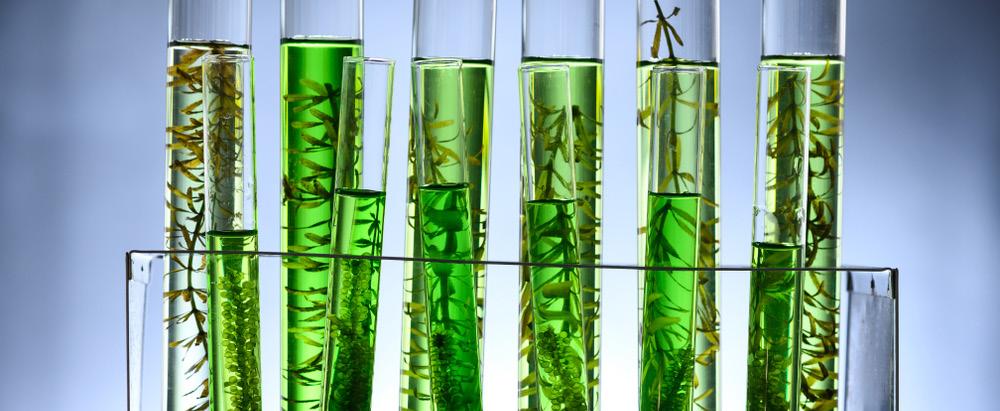
TriNutra® Receives US Patent for Unique ThymoQuin® Composition
TriNutra, the supplier of the first cold-pressed black seed (Nigellasativa (NS)) oil standardized to 3% thymoquinone and extremely low free fatty acids, has announced its recent U.S. patent for the unique composition of its branded ingredients, ThymoQuin®, B’utyQuin™ and ThymoQuin®-OCare.
The patent states, “This present invention is directed to a cold-pressed NS oils containing concentrations of thymoquinone (TQ) that are significantly higher than obtained in prior NS oils of this type. Since many of the therapeutic and healthpromoting activities of NS oils are related to their TQ content, the oil compositions of the present invention provide a significant technical advance since, on the one hand, they possess high concentrations of the active agent (TQ), while on the other hand, maintaining a full spectrum oil and the inherent composition of the oils in the seeds. In addition, they are free from the safety, regulatory, cost-related and other disadvantages associated with prior high-TQ NS extracts produced by using selective solvent extraction techniques.”
Thymoquinone is a key and potent active component in Nigella sativa (black seed) oil and is unstable in the presence of oxidants, like free fatty acids. This leads to reduced potency and rancidity of the black seed oil. It was, therefore, a major goal of TriNutra to find a way to standardize, stabilize and maintain the natural ratio and balance between the components of its black seed oil.
“Our unique formulation achieved our goal beyond expectations, tapping the success with increased stability, bioavailability, and efficacy of black seed oil,”
said Morris Zelkah, CEO of TriNutra. “ThymoQuin has brought innovation to this ancient ingredient with several published clinical trials on its health benefits and efficacy, and numerous global patents back it for its composition, stability, bioavailability, and use. We are incredibly proud of yet another achievement for ThymoQuin and its potential in human health.”
Additionally, the patent reviews other essential composition components of the black seed oil, specifically carvacrol, p-cymene, and low free fatty acid (FFA) content

ThymoQuin® achieves its specific composition, 3% TQ, less than 1.25% FFA, and a p-cymene minimum of 1.2% due to its strict growing, harvesting, and proprietary manufacturing processes. The published clinical data recognizes ThymoQuin to support a balanced inflammatory response, improving mitochondrial activity, including ATP production, and delivering excellent antioxidant capacity and antimicrobial effects. It is applicable for dietary supplements as ThymoQuin®, cosmeceuticals (B’utyQuin), oral health ThymoQuin®-OCare and more.
To learn more about ThymoQuin®, schedule an interview with Morris Zelkah while at Natural Products Expo West in Anaheim, California, by contacting: service@trinutra.com or visit TriNutra.com.
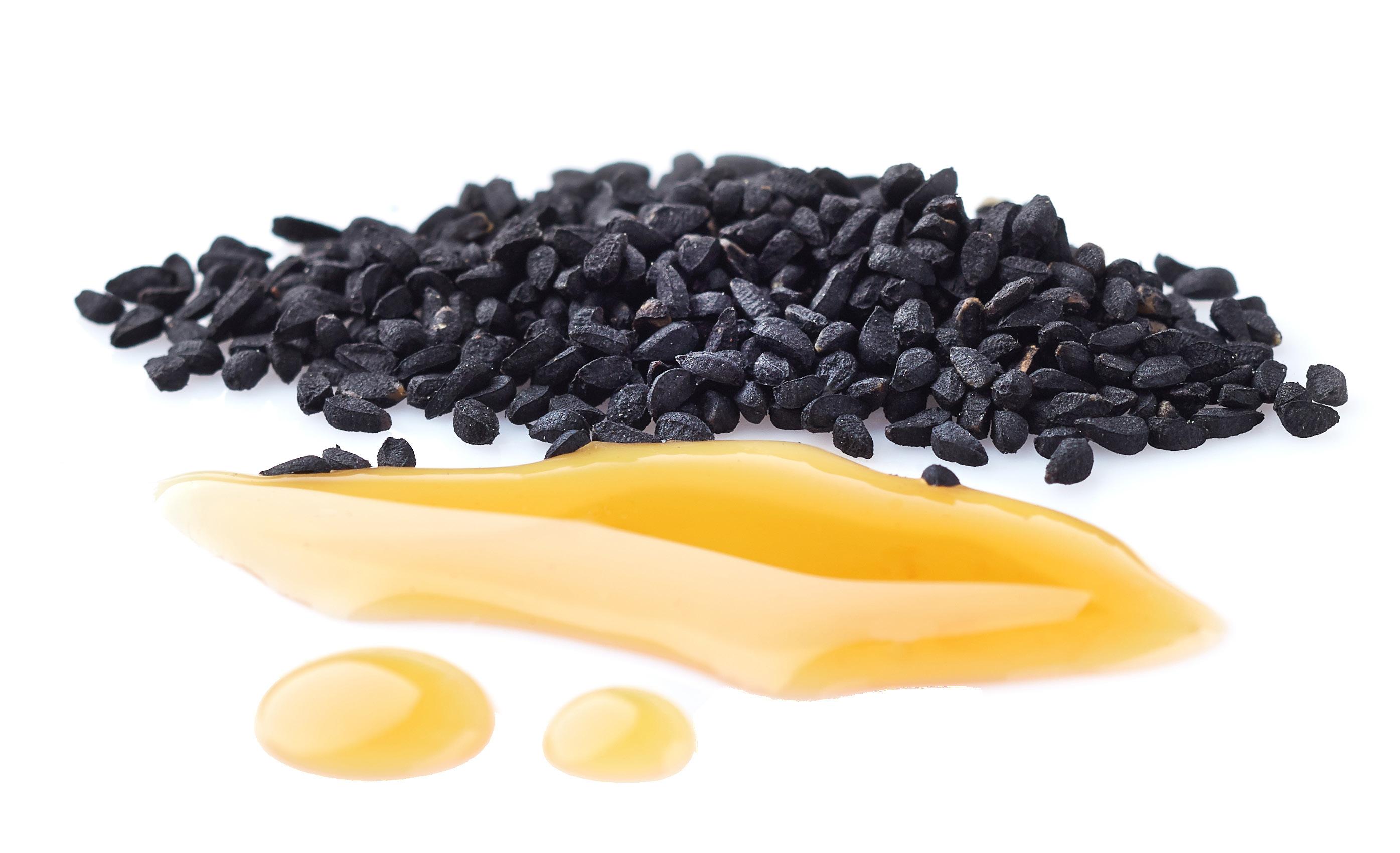
Study Reveals Pomegranate’s Potential to Slow Progression of Age-Related Frailty
Euromed extract reverses loss of motor coordination and prevents oxidative stress in ageing mice, according to independent research study conducted at the University of Valencia (Spain).

Arecently published study shows that Euromed’s pomegranate extract Pomanox® can promote healthy ageing in mice.1 The substance was found to prevent frailty, improve motor skills and reduce oxidative stress in the cerebellum, the part of the brain responsible for coordination. Falling and subsequent bone fractures are one of the major health risks in elderly people. Therefore, the researchers of this model study looked at how to overcome the problem by addressing balance and stance, which are controlled by the cerebellum.
The cerebellum is also responsible for coordination of voluntary movements, motor learning and cognitive tasks. During the ageing process, most of these functions deteriorate, resulting in falls and accidents. In the study, Pomanox® was able to maintain antioxidant levels in elderly mice after four months of supplementation. This effect was particularly evident in the cerebellum. Moreover, the standardised pomegranate extract influenced gene expression related to the apoptosis pathway, suggesting support for healthy ageing. Although no changes in grip strength and endurance were found, the results showed that pomegranate extract supplementation improved the motor skills in terms of coordination and neuromuscular function, and helped prevent age-related weight loss. Thus, the researchers believe that Pomanox® may provide practical nutritional support for common health problems, such as frailty, in later life.
Pomegranate’s health benefits come from puni-
calagins, which are among nature’s strongest antioxidants. Pomanox® contains up to 30 per cent punicalagins and is a well-researched botanical ingredient from Euromed’s Mediterranean fruit and vegetable extracts range. It is obtained via a quality-controlled, transparent and sustainable local supply chain, and gently processed with an eco-friendly, proprietary technology.
Andrea Zangara, Head of Scientific Communication and Medical Affairs at Euromed, says: “Pomanox® is already well known to provide benefits for cardiovascular and metabolic health, satiety, sports performance, mood, skin and cognitive health. The novelty of this work focuses on the fact that the pomegranate extract could be used to help prevent deterioration associated with normal ageing. The authors of this independently conducted study have observed for the first time that the cerebellum is the area where ageing is first noticed in a model without pathology. As Pomanox® acted efficiently here, it could be a helpful tool to reduce the risk of falls so common in ageing, and other functional impairments.”
For further information visit: www.euromedgroup.com
References:
1 Verdú, D. et al. Pomegranate Extract Administration Reverses Loss of Motor Coordination and Prevents Oxidative Stress in Cerebellum of Aging Mice. Antioxidants 2023, 12, 1991. https://doi. org/10.3390/antiox12111991.
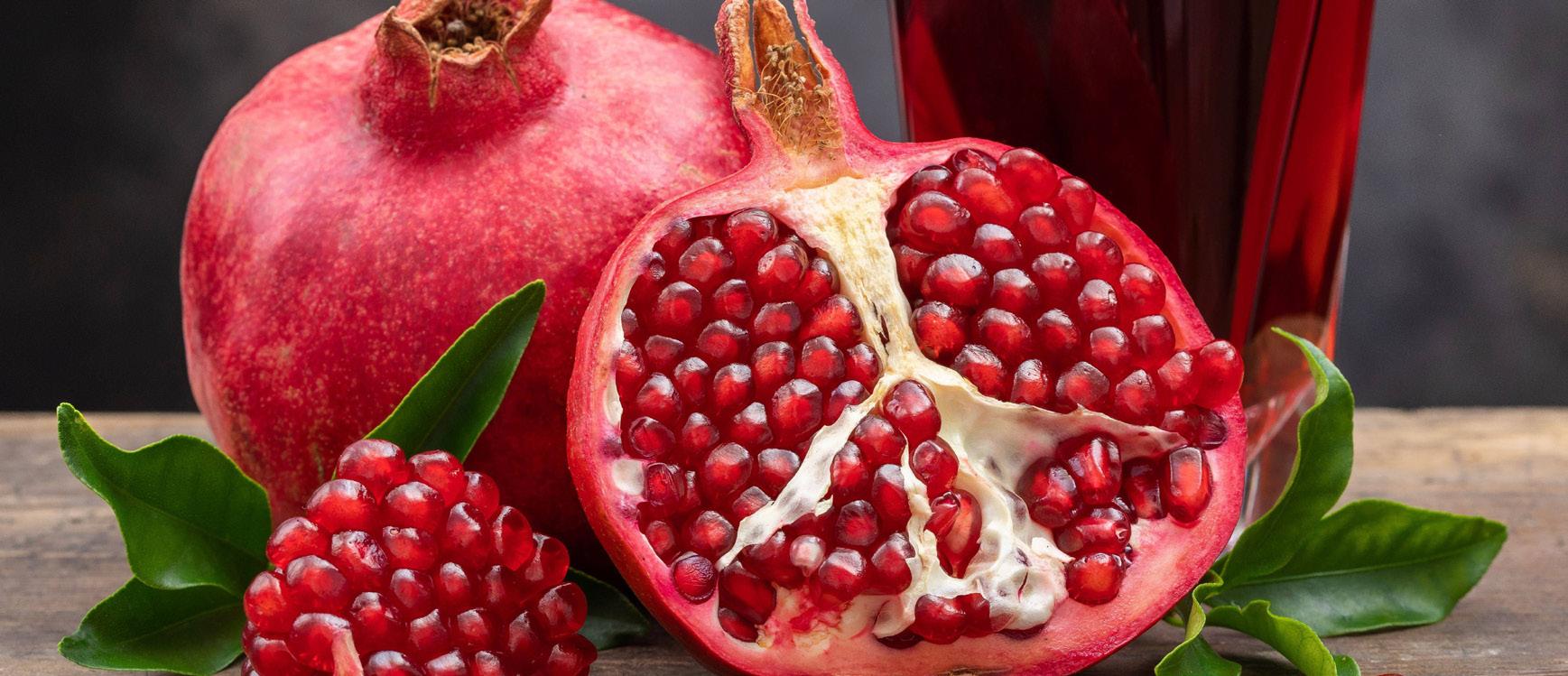
Go discover world-class networking
Meet leading influencers and decision-makers from across the nutraceutical industry
14-16 May 2024 Geneva
vitafoods.eu.com

Go Discover: Registrations Open for Vitafoods Europe 2024 in Geneva
The world’s nutraceutical event returns bigger and better than ever for its 26th and final year in Geneva, with new must-see content and features addressing the whole supply chain.

Registrations are open for Vitafoods Europe 2024 (14-16 May), the leading global platform for the nutraceutical, functional food and beverage, and dietary supplement industries. After 26 highly successful years in Geneva, the 2024 edition of the world’s nutraceutical event is anticipated to be the biggest yet, featuring the debut of a Technology & Equipment Area and a R&D Pavilion, as well as an expanded Finished Products Area. Over 20,000 visitors and 1,100 exhibitors are expected to attend the Palexpo exhibition centre this May before the event’s relocation in 2025.
The event’s returning and new features will offer even more opportunities for collaboration across the full supply chain – including suppliers, retailers, distributors and brand owners, like Arla, P&G and Coca-Cola. Plus, back by popular demand, the Future of Nutrition Summit (13 May, Marriott Hotel) and Vitafoods Europe Conference (14-15 May) return for 2024. To celebrate the event’s last year in Geneva and to thank the nutraceutical community for its continued support over the years, the Vitafoods Europe Conference will be free to attend on the show floor, providing access to industry-leading content for all.
From humble beginnings to a global community
Vitafoods Europe launched in 1997 with just 100 exhibitors, 1,200 attendees and a mission to create a platform that meets the growing demands of the emerging nutraceutical industry. The event has since grown to be the leading global event for nutraceutical, functional food and beverage, and dietary supplement professionals, welcoming tens of thousands

of visitors and more than 1,100 exhibitors each year. Reflecting on the brand’s journey, Julien Bonvallet, Group Brand Director at Informa Markets remarks: “We could never have imagined all those years ago that our small corner of the Palexpo exhibition centre would grow to the bustling hub of the industry we see today. Our success is not only measured in the size or scale of the event, but also the astounding love and loyalty shown to the event by the nutraceutical community that continues to this day. As always, we’re committed to growing and evolving our offering in line with market developments and community needs, to keep us at the heart of the nutraceutical industry for many years to come.”
Go discover
Designed to inspire connection, innovation and positive change across all corners of the supply chain, Vitafoods Europe has established itself as the go-to annual event for the nutraceutical industry. The 2024 edition will balance new features and content with all-time favourites, making it an event not to be missed. Highlights include:
• The Future of Nutrition Summit (13 May, Marriott Hotel, Geneva) – designed for independent futurist thinkers throughout the industry and beyond, this exclusive paid-for one-day summit will offer a snapshot of the nutrition industry in 5+ years’ time, diving deep into the future of health, product development and retail. It will also provide opportunities to network with C-level experts from a range of diverse disciplines, including food science, sustainability, retail, nutrition and public health, as well as start-ups, scale-ups and investors.

The Vitafoods Europe Conference (14-15 May) –free to attend in 2024, this two-day conference will see experts from across the field present datadriven and evidence-based solutions, the latest research, ingredient insights, innovations and formulation strategies within the biggest trends in nutrition today. Visitors can discover expert insights across a range of health benefit areas, including sports nutrition, immune and gut health, cognitive and emotional health, and healthy ageing.
• The NEW Technology & Equipment Area and R&D Pavilion – this year, Vitafoods Europe introduces its first ever area exclusively dedicated to the technology and equipment innovations driving the industry forward. Created in response to visitor demand, it will bring together leading players in technology innovation – such as IMA, OMAG and Marchesini Group – to showcase their cuttingedge solutions in action.
• The Finished Products Area – back and bigger than ever, the expanded 2024 Finished Product Area provides even more opportunities for manufacturers to connect with leading brands, retailers and distributors. With the likes of Nestlé, Mars, Holland & Barrett and Wholefoods visiting the event each year, the Finished Products Area is the go-to place to discover the latest innovative concepts and market-ready products on offer.
The Vitafoods Insights Theatre – this renowned theatre returns to the show floor, hosting a range of free expert-led content. Attendees from all sectors can discover insights to help their businesses overcome the real-world challenges facing the industry today, with sessions on sustainability, regulatory, market challenges and more.
An invitation not to be missed
“Over the last two decades, Vitafoods Europe has become the go-to annual event in the nutraceutical calendar – and this year is no exception. Vitafoods Europe 2024 not only marks our final chapter in Geneva, but also the next step in our commitment to serve the needs of businesses and professionals across the nutraceutical industry,” says Julien Bonvallet. “To mark the occasion, the 2024 event will be our best yet. This year, we have introduced new show features dedicated to pushing the boundaries of innovation, for example the new Technology & Equipment Area. Vitafoods Europe is the only nutraceutical event to bring together the entire supply chain. This means suppliers, manufacturers, distributors, retailers and everyone in between are represented –helping key players reach new audiences and make meaningful connections to help take their business to the next level.”
“These past 26 years, particularly those at Geneva’s Palexpo, have been a privilege and we’re excited to invite everyone to join us here for one last time to discover what’s next for the nutraceutical industry and to celebrate the wonderful journey we’ve been on together.”
Registrations for Vitafoods Europe 2024 are now open – to secure your place or learn more about what’s on offer, visit: www.vitafoods.eu.com
B2B Events Calendar
Overview of live B2B events that will take place during 2024.








12-16 March 2024, Anaheim, CA USA
https://www.expowest.com/en/home.html
21-23 March 2024, Bologna, Italy
https://www.cosmoprof.com/en/
14-15 April 2024, London, UK
https://www.naturalproducts.co.uk/
16-17 April 2024, Secaucus, NJ, United States
https://east.supplysideshow.com/en/home.html
16-18 April 2024, Paris, France
https://www.in-cosmetics.com/global/en-gb.html
16-18 April 2024, Warsaw, Poland
https://nutrafood.pl/en/
19-21 April 2024, Bologna, Italy
https://www.cosmofarma.com/en/
14-16 May 2024, Geneva, Switzerland
https://www.vitafoods.eu.com/en/home.html
23-24 September 2024, Lyon, France
https://natexpo.com/en/


8-10 October 2024, Milan, Italy
https://www.cphi.com/europe/en/home.html
19-21 November 2024, Frankfurt, Germany
https://www.figlobal.com/europe/en/home.html
Cosmetic Claims: What is (Not) Allowed?
Consumer familiarity with cosmetic products relies heavily on product labeling, which not only provides necessary information but also serves as a persuasive tool for manufacturers to attract buyers. However, adherence to legal requirements is crucial to avoid misleading claims, which can lead to legal consequences. Upholding honesty, evidential support, and fairness in advertising claims is essential to protect consumers and maintain trust in the cosmetics industry.
 AUTHOR:
Gordana Gorinšek, MSc in Phytomedicine, Expert Cosmetic Safety Assessor, Expert Regulatory Affairs Consultant
AUTHOR:
Gordana Gorinšek, MSc in Phytomedicine, Expert Cosmetic Safety Assessor, Expert Regulatory Affairs Consultant
Every consumer when choosing a new cosmetic product, a product he is not familiar with, will familiarize himself with it by reading the information and messages printed on the product label.
In addition to legally required elements, the product label in most cases contains a short description of what the consumer can expect from the product, two to three shorter sentences in which the manufacturer addresses the potential consumer, presents it in its best light, and tries to persuade the consumer into buying a certain product. Along with the text, illustrations, symbols, etc. can often be seen on the product label, and they all serve as a communication channel between manufacturer and consumer.
There is nothing wrong with that as long as consumers are not manipulated, or misled, health claims are not made, and miracle effects are not attributed, in fact as long as the legal requirements are respected. In the strong desire for positioning on the market, but sometimes due to the lack of knowledge and understanding of manufacturers, and marketing experts also, these legal requirements are violated.
To protect consumers from malicious, dishonest and misleading moves by manufacturers, Article 20 of the Cosmetics Regulation defines the manner of advertising, therefore all claims are allowed as long
as they do not violate this article i.e., as long as they do not mislead the consumer. Article 20 specifically refers to product claims and point 1 states that: „In the labelling, making available on the market and advertising of cosmetic products, text, names, trademarks, pictures and figurative or other signs shall not be used to imply that these products have characteristics or functions which they do not have.“ This article applies to any claim, explicit or implicit, irrespective of the medium or type of marketing tool used (websites, social networks, newspaper ads, television shows, promotional leaflets, brochures, magazines, a review of an influencer or a public figure etc.) the product functions claimed, and the target audience.
Moreover, The Commission adopted common criteria by the Claims Regulation for the justification of claims made concerning cosmetic products and established 6 common criteria for claims, and all of these must be taken into consideration when advertising: legal compliance, truthfulness, evidential support, honesty, fairness, informed decision-making.
These are the most common examples of violation of the criteria from the Claims Regulation in practice:
1. Legal compliance - The manufacturer points out that its cosmetic products or production itself are

in compliance with legal requirements, or the products do not contain ingredients that are prohibited when it is known that every manufacturer that operates legally and every product that is legally on the EU market must comply with legal requirements and cannot contain prohibited ingredient(s). Usually, manufacturers emphasize that their production is compliant with good manufacturing practice guidelines or that products are notified to Cosmetic Products Notification Portal (CPNP).
2. Truthfulness - the manufacturer misrepresents that a cosmetic product contains an ingredient that is not present in the product. To clarify with an example, the manufacturer presents that the product contains honey, even though it contains only the aroma of honey. If a cosmetic product is claimed to contain a certain ingredient, that ingredient must explicitly be present in the product.
3. Evidential support - manufacturers can refer to different types of evidential support to substantiate their claims. Some examples of proof of claims are experimental studies, consumer perception tests, publications or a combination of these. The methods used should be reliable and reproducible, and the studies should follow a welldesigned and scientifically valid methodology. Studies have to be scientifically and statistically valid and conducted by a qualified and adequately experienced person. Most often manufacturers claim the specific effect of a cosmetic product based on the fact that the product contains an ingredient of such or similar effect, but without any studies carried out to substantiate the claim. In other words, the manufacturer highlights the function of one of the substances to be the function of the final product. The most commonly manipulated effect is the moisturizing effect.
4. Honesty - by presenting the cosmetic product, the manufacturer leads the consumer to believe that using a specific product will solve his problem or fulfil a desire, in an extremely short period of time, or falsely attributes to it an effect that the product simply does not have, due to the low concentration of the active substance in the product. A very simple and quite common example is a promise that the product removes wrinkles within a few days. Claims stating a cosmetic product’s therapeutic effect or biocidal effects can be found on the market also.
5. Fairness - the manufacturer defames competitors and legally permitted ingredients with claims. Most often manufacturer tries to present themselves as better than the competition in some way and present their cosmetic products, with the same or similar purpose or effect, as better and more effective than the competition’s. It is most often manipulated with preservatives and fragrances of synthetic origin. For example, the claim “free from parabens” is attractive for marketing purposes, but it denigrates legally authorised ingredients. On the other hand, claims addressing the absence of ingredients such as alcohol, essential oils or soap are considered to be compliant as the consumer needs to be able to choose to avoid these ingredients for specific reasons such as allergies.
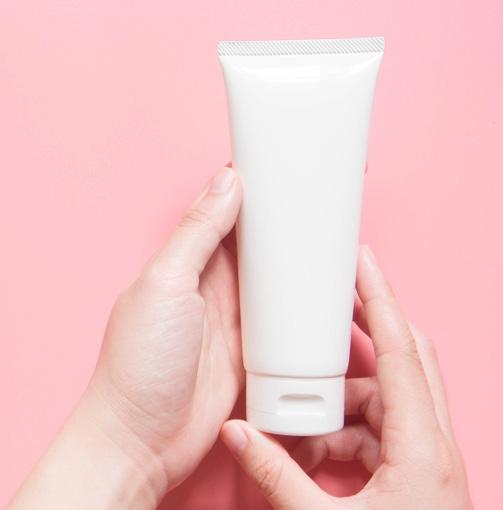
6. Informed decision-making - the manufacturer uses technical terms, and insufficiently clear and comprehensible language for the average consumer, regardless of the consumer's age and level of education, which prevents the consumer from making an informed choice. The most frequently used technical terms related to the mechanism of action of specific active substances.
At the end of all the above, if the consumer is misled, this is then referred to as a criminal offense, because advertised claims were not properly stated and/or proven.
Because formulating claims is very delicate and slippery ground, smart claims are a state of verbal and graphic art. Smart claims are puns, anagrams, and expressions of literary creativity in which respect for the law and the consumer is felt, and should not be left to editing by people from fields not related to the cosmetic industry, cosmetic beginners, or cosmetic experts with none or too little experience with this subject.
No manufacturer wants to take such a risk and therefore should never refrain from carefully checking their claims or consulting experienced cosmetic experts before using them in advertising.
References:
1 Regulation (EC) No 1223/2009 of the European Parliament and the Council of 30 November 2009 on cosmetic products
2 Regulation (EU) No 655/2013 of 10 July 2013 laying down common criteria for the justification of claims used in relation to cosmetic products

Aromatični kutak Ltd. Brune Bušića 21 Zagreb, Croatia https://pif.com.hr/ info@aromaticnikutak.hr T. + 385 98 1750 934
Pomegranate Seed Oil: Unveiling Its Health-Promoting Potentials and Cosmeceutical Skin Benefits
Pomegranate seed oil, derived from the ancient fruit Punicagranatum L., has garnered significant attention for its diverse health benefits and potential applications in skincare. Rich in antioxidants and bioactive compounds like punicic acid, this oil demonstrates antiinflammatory, antimicrobial, and cardioprotective properties. Moreover, research suggests its promising role in promoting skin health, including wound healing, collagen regeneration, and anti-ageing effects, making it a valuable ingredient in cosmeceuticals.
Pomegranate seed oil, derived from the ancient fruit Punica granatum L., has garnered significant attention for its diverse health benefits and potential applications in skincare. Rich in antioxidants and bioactive compounds like punicic acid, this oil demonstrates anti-inflammatory, antimicrobial, and cardioprotective properties. Moreover, research suggests its promising role in promoting skin health, including wound healing, collagen regeneration, and anti-ageing effects, making it a valuable ingredient in cosmeceuticals.
The pomegranate (Punica granatum L.) is an ancient fruit that has been widely used in traditional medicine and has increasingly gained popularity among consumers in managing different facets of health. Pomegranate, a superfruit native to Israel and the
Middle East, has gained widespread popularity as a functional food and nutraceutical source.
Pomegranate fruit can be processed into different food products like juice, nectars, jams, pomegranate fruit extract, peel extract and seed oil. Pomegranate fruit contains a high content of antioxidants. Fruit skin is the most used for medicine purposes, followed by seeds, and whole fruit. The food industry understands the value of seeds and seed meal cake, a by-product of seed oil cold pressing. Converted to powders, these seeds become a valuable source of nutrition - plant protein, dietary fibre, vitamins and minerals.
Health-promoting benefits of vegetable oils

To be able to have a better idea of the importance of vegetable oils including pomegranate seed oil, the next study is very important to mention.
In a study reviewing 39 vegetable and speciality seed oils, covering their chemical compositions, nutritional properties, and health-promoting benefits, seed oils rich in EFAs, also known as essential fatty acids, play an essential role in a healthy diet. EFAs are found in plant seed oils and animal-derived fats such as butter, shortening and lard. Adults need an appropriate amount of oil intake of 22–44 g/day depending on the number of calories required per day. The intake of vegetable oils from various sources has distinctive effects on human health including antioxidant activity, anti-cancer, anti-inflammatory, prevention of CVD, anti-obesity, diabetes treatment, kidney and liver protection, and other health effects. These health benefits are ascribed to fatty acids, tocopherols, phytosterols, carotenoids, squalene, and phenolics content accordingly. The increasing attention given to the functional compounds in vegetable and specialty seed oils, oils and their correlations


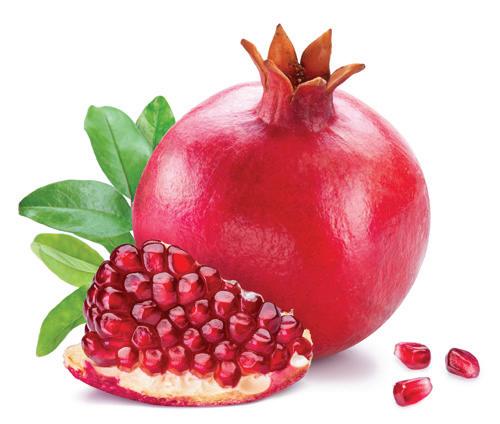


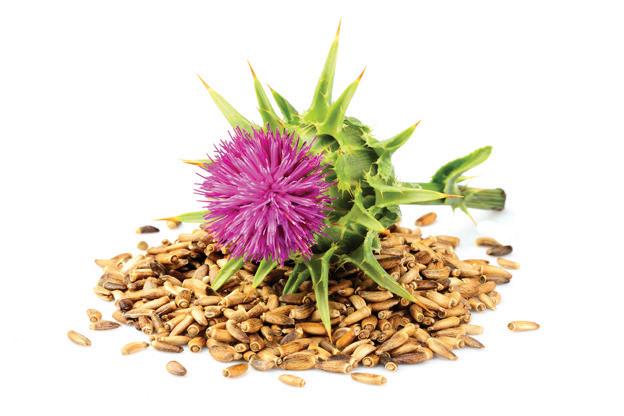


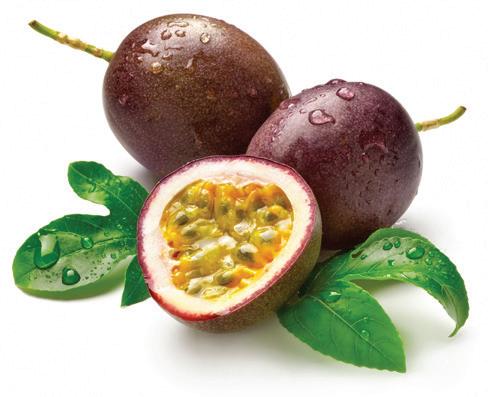


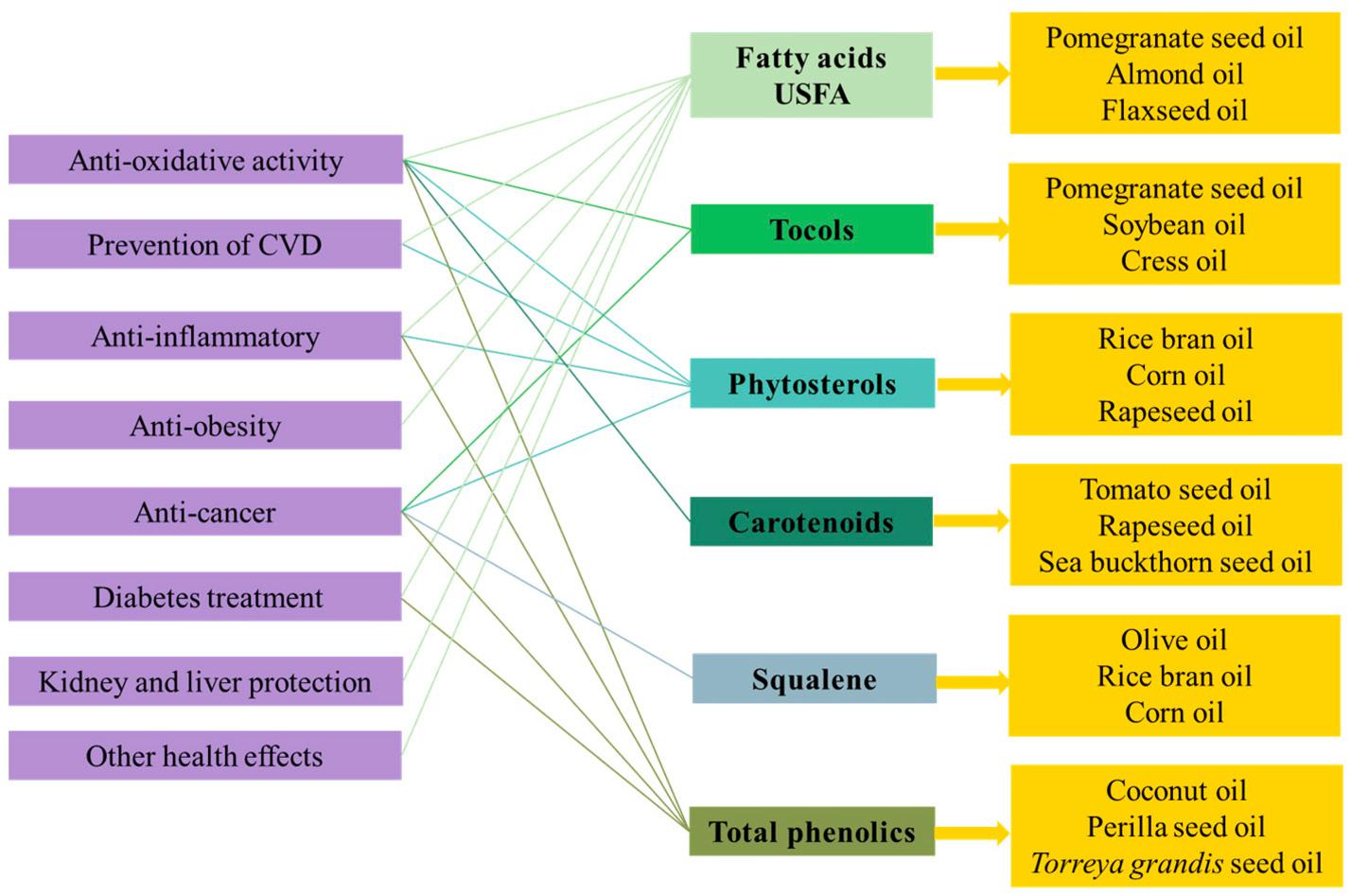
to human health effects in recent years is due to increasing public awareness.
This review reports that different types of vegetable and specialty oils have their specific advantages and functional nutritional properties; thus, appropriate vegetable and specialty oils need to be selected to meet individual needs accordingly. To clarify the functional substances' correlation to the health benefits, based on the richness of each key component, the representative vegetable and specialty oils are summarized and recommended in Figure 1.
Therefore, according to Figure 1, to prevent cardiovascular diseases, more unsaturated fatty acids and phytosterols should be supplied through the consumption of pomegranate seed oil, almond oil, flaxseed oil, rice bran oil, corn oil, or rapeseed oil. Similarly, considering diabetes prevention, more phenolics and FAs need to be incorporated through the intake of coconut oil, perilla seed oil, pomegranate seed oil, almond oil, or flaxseed oil1 .
The production process of pomegranate seed oil
An important feature of the production of Pomegranate seed oils is method of the production. It has been proven that the best production method is cold pressing.
Pomegranate seeds are the richest source of this exotic, fruity aroma oil with healing and antioxidant potential for the skin. Pomegranate seed is extracted by various methods including organic solvent extraction, supercritical CO2 (SC-CO2) extraction and
cold pressing. To preserve the valuable sterols, polyphenols, tocopherols, and octadecatrienoic acid (punicic acid), cold pressing is preferred as it allows pomegranate seed oil to retain its physiochemical and nutritional qualities while being environmentally friendly. 2
MediVega™ oils start with a thorough, stringent green process. This cold press technology is powered by the sun – solar power, and creates zero waste reducing our ecological footprint. Produced oil is kept under appropriate conditions to prevent oxidation while preserving the oil's natural benefits -vitamins, minerals, fatty acids and other phyto-actives.
Chemistry of pomegranate seed oil
The Pomegranate seed oil has high phytosterol content and a unique fatty acid profile that includes punicic acid, a conjugated linolenic acid isomer. Results of the study (Kaufman & Wiesman 2007)3 showed linolenic acid to be the predominant fatty acid in the pomegranate seed oil. Phytosterols were found in quite a high concentration in the pomegranate seed oil (4089–6205 mg/kg) about 3−4-fold higher than in soybean oil. A detailed profile of the phytosterols in the pomegranate seed oil showed a wide variety, the major phytosterols being β-sitosterol, campesterol, and stigmasterol3. The FDA and EFSA have approved the following health claim for phytosterols: foods containing at least 0.65 g per serving of plant sterol esters, eaten twice a day with meals for a daily total intake of at least 1.3 g, as part of a diet low in saturated fat and cholesterol, may re-
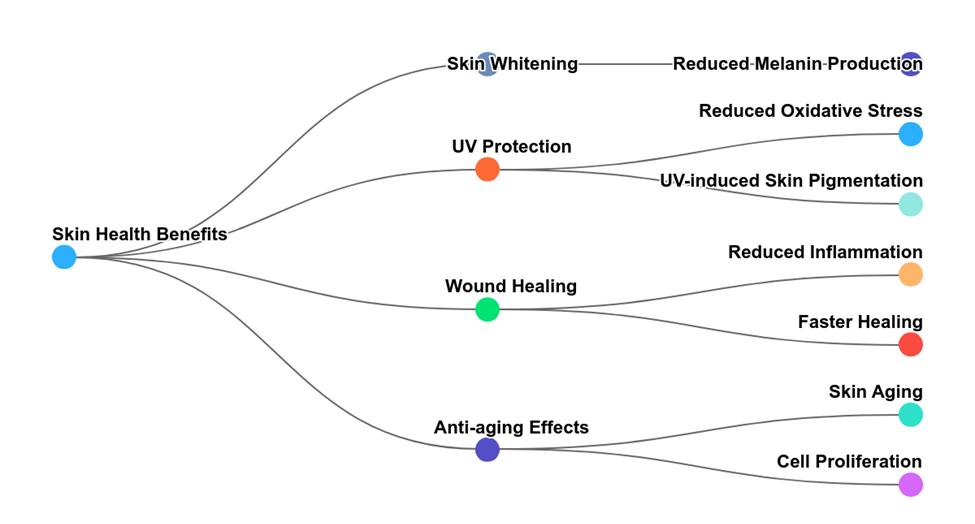
duce the risk of heart disease.
The high sterol content may suggest the exploitation of PSO as a low-cost renewable source of phytosterols for industrial processing in the fields of cosmetics, drugs and nutraceuticals. Pomegranate seed may be a promising nutraceutical ingredient accounting for both its abundance and phytochemical quality4
It is also a rich source of tocopherols, Vitamin C and carotenoids.
The potential of pomegranate seed oil in supporting healthy skin
The distinctive chemical makeup of pomegranate seed oil has sparked research focused on its beneficial impacts, such as aiding in weight management, promoting skin healing, and modifying blood lipid profiles in people with hyperlipidemia.
Anthocyanins and the unique fatty acid profile of the seed oil may also play a role in pomegranate's health effects.
As previously mentioned, pomegranate seed oil contains punicic acid, a conjugated linolenic acid which has demonstrated anti-inflammatory and antioxidant effects.
Punicic acid, a bioactive compound of pomegranate seed oil has gained wide attention for its therapeutic potential. Different studies conducted on animal and human models have revealed that punicic acid is very effective against various chronic diseases.
However, while the potential benefits of pomegranate seed oil for skin health are supported by research, the specific effects of consuming pomegranate seed oil on skin health have not been extensively studied. Further research is needed to fully understand the impact of pomegranate seed oil consumption on skin health. The oil also contains elevated amounts of tocopherols, such as α-, γ-, and
δ-tocopherols, which are of technological and nutritional relevance and have antioxidant properties
These chemical attributes make pomegranate seed oil a promising source of beneficial compounds for skin health (Figure 2).
Skin care studies
Skin care products containing pomegranate extracts and seed oil are increasingly available and promise rejuvenation, youthfulness, and beauty. However, research on the ability of pomegranate to act as an effective cosmeceutical ingredient is in the early stages of development.
In human cell cultures, pomegranate seed oil increased the number of keratinocytes increasing the thickness of the epidermis and pomegranate peel extract did not affect keratinocytes, but increased the number of fibroblasts in a dose-response fashion, indicating stimulation of dermal repair mechanisms5
In this study, aqueous fractions prepared from the fruit's peel and fermented juice and lipophilic fractions prepared from pomegranate seeds were examined for effects on human epidermal keratinocyte and human dermal fibroblast function. Pomegranate seed oil, but not aqueous extracts of fermented juice, peel or seed cake, stimulated keratinocyte proliferation in monolayer culture. In parallel, a mild thickening of the epidermis (without the loss of ordered differentiation) was observed in skin organ culture. These results suggest the heuristic potential of pomegranate seed oil promoting regeneration of the epidermis5.
Anti-aging effect of pomegranate seed oil
Pomegranate seed oil is rich in antioxidants such as punicic acid and tocopherols. Antioxidants are known for their potential anti-aging properties by

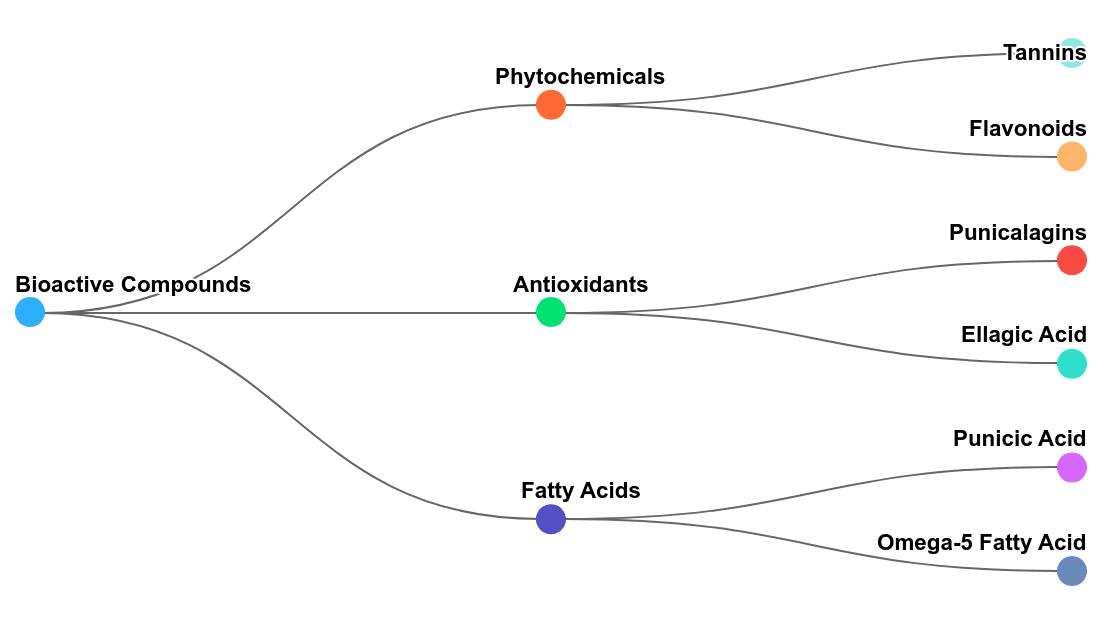
combating oxidative stress and protecting against cellular damage. Pomegranate seed oil has been found to have anti-inflammatory and healing effects, promoting collagen regeneration and enhancing fibroblast proliferation
The bioactive compounds in pomegranate seed oil interact with skin cells to improve elasticity through their anti-inflammatory and antioxidant effects. The mechanism of action of these bioactive compounds at a molecular level involves their ability to scavenge free radicals, protect the skin matrix, and promote collagen synthesis.
The specific bioactive compounds in pomegranate seed oil that contribute to improved skin elasticity are punicic acid and tocopherols, including α-, γ-, and δ-tocopherols.
These bioactive compounds interact with skin cells to improve elasticity through their anti-inflammatory and antioxidant effects. At a molecular level, the mechanism of action of these bioactive compounds involves their ability to scavenge free radicals, protect the skin matrix, and promote collagen synthesis.
The regulatory framework in Europe
According to the conclusion reached by the French competent authorities (DGCCRF) in response to a request submitted according to the requirements of Commission Implementing Regulation (EU) 2018/ 4566 on the procedural steps of the consultation process for the determination of novel food status, Pomegranate (Punicagranatum L. ) seed oil is considered novel food for all uses6
Conclusion
In conclusion, scientific research suggests that pomegranate seed oil offers a variety of health benefits. Studies have shown its potential to reduce inflammation, protect against oxidative stress, and promote heart health due to its high content of bio-
active compounds such as punicic acid and antioxidants. Additionally, pomegranate seed oil exhibits antimicrobial properties, which may contribute to its effectiveness in supporting overall health and wellness. While further research is warranted to fully understand the mechanisms and optimal dosages for specific health outcomes, the existing evidence indicates that incorporating pomegranate seed oil into a balanced diet may offer notable health advantages.
There is already a lot of relevant proof that pomegranate seed oil contributes to various health benefits. Also, it has been proven that when applied topically it can contribute to skin health in various ways, including supporting wound healing and collagen production, UV protection, nourishing and anti-aging thanks to antioxidant and vitamin E content. Nutraceutical potential of pomegranate seed oil is yet to be fully discovered.
References:
1 Tian M, Bai Y, Tian H, Zhao X. The Chemical Composition and Health-Promoting Benefits of Vegetable Oils—A Review. Molecules. 2023; 28(17):6393. https://doi.org/10.3390/molecules28176393
2 Shabbir MA, Khan MR, Saeed M, Pasha I, Khalil AA, Siraj N. Punicic acid: A striking health substance to combat metabolic syndromes in humans. Lipids Health Dis. 2017;16(1):99. Published 2017 May 30. doi:10.1186/s12944-017-0489-3
3 Kaufman M, Wiesman Z. Pomegranate oil analysis with emphasis on MALDI-TOF/MS triacylglycerol fingerprinting. J Agric Food Chem. 2007;55(25):10405-10413. doi:10.1021/jf072741q
4 The high sterol content may suggest the exploitation of PSO as a low-cost renewable source of phytosterols for industrial processing in the fields of cosmetics, drugs and nutraceuticals. Pomegranate seed may be a promising nutraceutical ingredient accounting for both its abundance and phytochemical quality6.
5 Aslam MN, Lansky EP, Varani J. Pomegranate as a cosmeceutical source: pomegranate fractions promote proliferation and procollagen synthesis and inhibit matrix metalloproteinase-1 production in human skin cells. J Ethnopharmacol. 2006;103(3):311-318. doi:10.1016/j.jep.2005.07.027
6 https://food.ec.europa.eu/safety/novel-food/novel-food-statuscatalogue_en
Evonik Launches Biotech-Based Vegan Collagen Ingredient for the Beauty and Personal Care Market
Vecollage™ Fortify L - skin-identical collagen demonstrates superior performance and meets increasing market demand for vegan collagen.
Evonik has launched Vecollage™ Fortify L, a new vegan collagen for the beauty and personal care market that is identical to collagen in the skin. Vecollage™ Fortify L leverages Evonik’s competencies in biotechnology, collagen, and skin care to meet the demand for vegan collagen for applications such as anti-aging and hydrating creams. By using a system solutions approach that combines an innovative product with expertise in skin biology, Evonik has unveiled the effect of recombinant collagen on the dermis, the middle layer of the skin.
The launch of Vecollage™ Fortify L brings Evonik a step closer to generating a platform of non-animal and sustainable collagen. This platform will consist of several types of vegan collagen developed by Evonik and together with partners and will cement the company’s position as a prominent player in biotechnology-based active ingredients. Bioactives form part of a growing portfolio of innovative biosolutions developed by the company’s life sciences division, Nutrition & Care.
“The future of skincare is all about biotech-based collagen! Brand owners can now offer consumers sustainably sourced, skin-identical collagen. This true hero ingredient clearly shows how sustainability drives us and collaboration defines us,” said Yann d'Hervé, head of Evonik's Care Solutions business line.
Vecollage™ Fortify L was developed in partnership
with the company Modern Meadow Inc., which specializes in fermentation-based protein development. It provides dual benefits to fortify collagen in the skin by preventing age-related degradation and stimulating the skin’s own collagen production.
For decades, collagen has been a sought-after ingredient in cosmetics and dermatology for its ability to improve firmness, elasticity and hydration in the skin. Traditionally, collagen comes from animal and marine sources, but consumers are increasingly looking for ethical and sustainable alternatives, while brands are concerned about supply security issues. Vecollage™ Fortify L is made using fermentation technology, which addresses these challenges by delivering a vegan collagen produced in a controlled manner with a lower ecological footprint.
The Care Solutions business, part of the Nutrition & Care division, specializes in concepts for skin care, sun care, color cosmetics, hair care, skin cleansing, active ingredients, alternative preservation and product stabilization. Evonik’s Nutrition & Care division is home to the company’s biotechnology excellence center which applies fermentation technologies in various high-growth markets.
For further information visit: https://personal-care.evonik.com/en or Evonik’s intoBeauty.evonik.com portal


Cosmoprof Worldwide Bologna
With its 55th edition, Cosmoprof Worldwide Bologna confirms its status as a global reference event for suppliers, manufacturers, brand owners, buyers, distributors, retailers and operators interested in new solutions for the development of their cosmetics business.

Cosmoprof Worldwide Bologna is set to celebrate its 55th edition with highly positive results. Over 3,000 companies from 67 countries have confirmed their presence (+4% compared to 2023), and the exhibition area is sold out. 58% of exhibitors come from European countries, 42% from outside Europe. 35% of total exhibitors are showcasing at Cosmoprof for the first time: the percentage is particularly noteworthy compared to 2023. The participation of 30 country pavilions confirms the international appeal of the event; they will showcase the best of national production for Australia, Brasil, China, Czech Republic, France, Germany, Greece, India, Indonesia, Ireland, Japan, Korea, Latvia, Poland, Romania, Spain, Sweden, Taiwan Region, Turkey, Ukraine, UK, USA. New to the 2023 edition is the presence of Estonia, Norway, the Pacific Islands, Palestine, and Singapore.
The positive results regarding exhibition offerings also influence visitor registrations and online ticket sales. For the 2024 edition, from September until now, the Cosmoprof website has recorded over 1.7 million views from approximately 217 countries and regions worldwide. Compared to the previous edition, there has been an increase in traffic, with +204% in terms of users and +32% in terms of web-
site registrations, thanks to the promotional campaigns activated in recent months on the main digital channels. The official social media profiles of the event are also experiencing steady growth, totalling over 400,000 followers. For the 2024 edition, online ticketing was activated earlier than in previous editions, a strategy that has proven successful with significant growth compared to 2023, especially in registrations from international operators. As of today, visitors from over 110 countries registered for the event. The collaboration with the Ministry of Foreign Affairs and International Cooperation in Italy and with ITA – Italian Trade Agency is incentivising the participation of more than 90 delegations with the most important importers, distributors, and retailers worldwide.
Cosmoprof Worldwide Bologna will benefit from collaboration with Cosmetica Italia - Italian Association of Cosmetic Companies.
These results reflect the general confidence and optimism of the market, as well as the positive reception of the event's new format, with the coordinated opening of all pavilions on the same day, Thursday, March 21st, to facilitate a multi-channel approach. Cosmopack and Cosmo Perfumery & Cosmetics will be open for 3 days and will close on Sat-

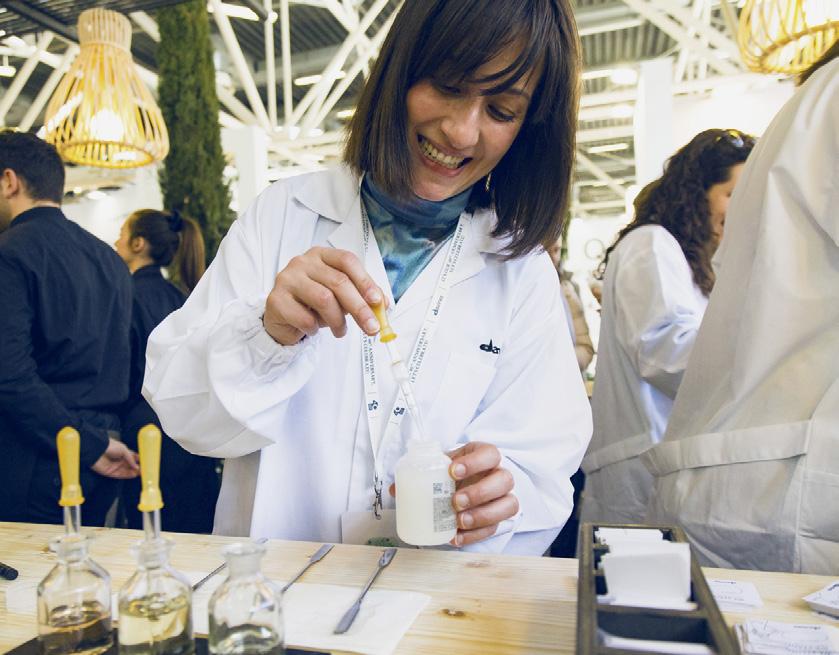
urday, March 23rd. The pavilions dedicated to the professional channels of Cosmo Hair Nail & Beauty Salon will be open for 4 days and will close on Sunday, March 24th. The decision to revise the dates is motivated by changes in the habits of industry operators. The opening of all pavilions on Thursday will facilitate contact between companies and international operators across all distribution channels. A significant change is that the fair will be closed on Monday, reflecting actual transformations in the professional channel: Monday is a working day for most professional salons. Salon owners and operators of beauty centres will finally have the opportunity to visit the fair on Thursday and Friday, usually the days most dedicated to business.
"As it reaches its 55th edition, Cosmoprof Worldwide Bologna is poised to experience four days of highly positive results, reaffirming its status as a global reference event for suppliers, manufacturers, brand owners, buyers, distributors, retailers, and operators interested in new solutions for the development of their businesses," emphasizes Gianpiero Calzolari, President of BolognaFiere. "The cosmetics industry is experiencing an exciting moment globally: according to McKinsey & Company's beauty report for 2023-2027, the sector reached a turnover of 427 billion dollars in 2023, and it is forecasted to reach 580 billion dollars by 2027, with an annual growth rate of 6%. In this context, Cosmoprof can offer fundamental support for companies and operators."
"The beauty industry is one of the sectors where innovation and research aimed at wellness and sustainability blend to create world-renowned products of excellence," says Matteo Zoppas, President of ITA - Italian Trade Agency. "Export data confirms the potential of the sector, which in the first ten months of 2023 showed double-digit growth (+21.9%) compared to the previous year, bucking the national average trend (+0.7%), reaching over 6.3 billion euros. Promoting investments and innovation, along with business-matching opportunities between Italian companies and players in established as well as emerging markets, is crucial for the growth and competitiveness of Made in Italy in this sector. That's why the Italian Trade Agency is participating in Cosmoprof again this year, the main event of the Italian beauty industry on a global scale. In close synergy with all the country's stakeholders involved in the Diplomacy for Growth projects, we continue to invest in trade fair platforms, contributing to the positioning and dissemination of Italian beauty worldwide."
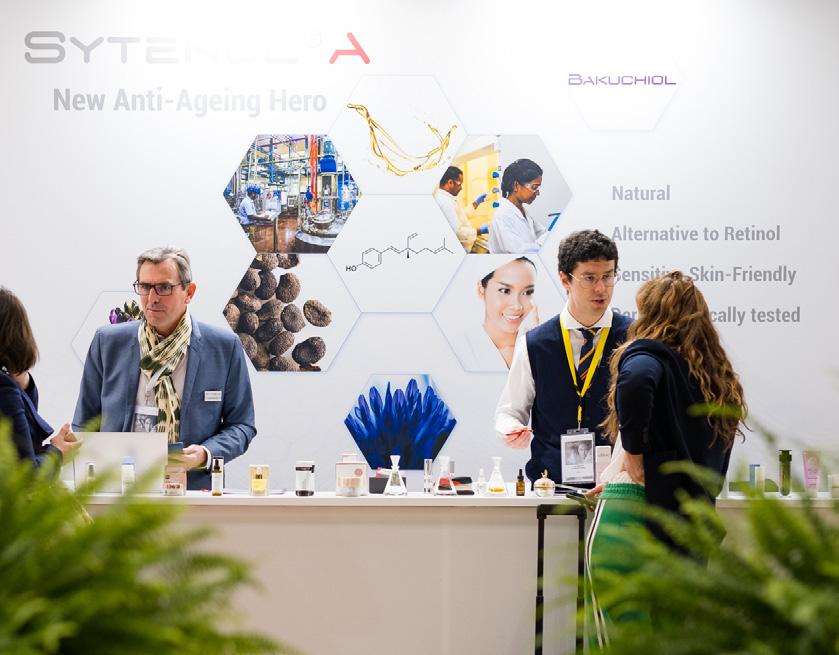
“Cosmoprof Worldwide Bologna is the place where an entire industry, a chain involving in Italy about 390,000 professionals from production to distribution, meets up” says Benedetto Lavino, President of Cosmetica Italia – The Personal Care Association. “On this occasion, we highlight national excellence which creates value for the entire country and is appreciated abroad for its high standards of quality, safety, innovation and creativity: according to preliminary data, the overall turnover of the Italian cosmetic industry reached 15 billion euros in 2023, with 7 billion euros related to exports. Thanks to the 50-year-old partnership between Cosmetica Italia and BolognaFiere Cosmoprof, two national excellences, the beauty Made in Italy and the most important fair for the cosmetic sector, renew cooperation which enables to underline the value of the beauty industry towards stakeholders and institutions”.
Cosmoprof Worldwide Bologna is the most important event within the international Cosmoprof platform, which, with its events in Hong Kong, Mumbai, Las Vegas, Bangkok, and, starting this year, Miami, offers unique international business opportunities. The excellence of its services and the presence of key players across all industry sectors make participation in Cosmoprof a unique and unparalleled experience. It simultaneously provides an excellent exhibition, showcasing the most exciting innovations from every country worldwide, and offers high-quality training moments with the contribution of prestigious experts and opinion leaders. Furthermore, specific digital services tailored to the needs of individual operators and the expertise of a highly qualified team assist stakeholders in enhancing business relationships and developing new projects. Exclusive matchmaking tools such as Cosmoprof My Match and the Buyer Program, aimed at buyers worldwide, facilitate networking and new business contacts.
"Thanks to our services and ability to facilitate business relationships and exchange between supply and demand, we are a leading event in the trade fair market," emphasizes Enrico Zannini, General Manager of Bologna Fiere Cosmoprof. "The results achieved so far are the best testament to the quality of our work. From March 21st to 24th, we are preparing to welcome stakeholders to Bologna with tremendous enthusiasm to create synergies and guide the industry through the many transformations of the market."
For further information visit: www.cosmoprof.com
INSPIRATIONAL SUCCESS STORY
Viktoria Natural Cosmetics
The Viktoria brand offers two lines of dermatologically tested cosmetics. One line features products made with organically cultivated immortelle flowers from our plantation, while the other utilizes donkey milk sourced from our own farm. Our goal is to broaden distribution both domestically in Croatia and internationally, focusing especially on concept stores that appreciate the benefits of farm-to-face cosmetics.

n How did it all start, what inspired you and what was the original idea?
Once upon a time, one night out in Rome, a stranger approached me and asked for my phone number. At that time, I was not aware that he would be my partner in all the adventures that life brought upon us for the last 15 years. Such a fairy tale- love story could have continued in picturesque Rome. This is how the predictable finale of this story would look like. In it, the two of us would have continued to do our successful jobs and build successful careers in the Italian capital, but our true story is a somewhat unusual fairy tale.
A little harsher, a little heavier, sometimes with unusual twists – our fairy tale leaves us with premium cosmetics as its fruit. As great lovers of nature, we left our careers and Rome, registered a family business in Radučić near Knin, and from the beginning,

we had a vision and an idea to make a premium cosmetic product from raw materials that we grow ourselves. Despite the many challenges of the modern market, our dream of cosmetics bursting with quiet luxury– lives on.
I found a phrase - quiet luxury. Our cosmetics are not the classic luxury that you will find in a high-end cosmetics store. It is the luxury of the new age. Luxury that comes from nature, from that peace that our souls long for. But also the luxury of respecting that nature. How good is it to know that the donkeys that produced milk are happy. This happiness and good energy, besides high quality ingredients, is the signature of our cosmetics.
n What was needed from idea to realization?
Years of education followed, during which I obtained a diploma as a pharmaceutical technician, then as an aromatherapist, then numerous professional trainings in various sectors, from ecological cultivation of immortelle to the production of natural cosmetics. Considering that the essence of our cosmetics is a farm to face approach, we started a donkey farm whose milk we use in production, then immortelle, almond and flower plantations. In order to close the circle of production, we applied for projects from the rural development program, bought a distillery where immortelle essential oil is produced, and opened a certified laboratory where today we successfully produce only farm to face cosmetics.
n What products do you offer today, and where and how do you market them?
Today, Viktoria brand has two lines of dermatologically tested cosmetics, available on our webshop www.viktoria-naturally.com . One line is with immortelle flowers cultivated organically on our plantation, while the other one is with the donkey milk, produced by donkeys from our farm. Face cream with donkey's milk and oil serum with immortelle essential oil and macerates that we produce have been our
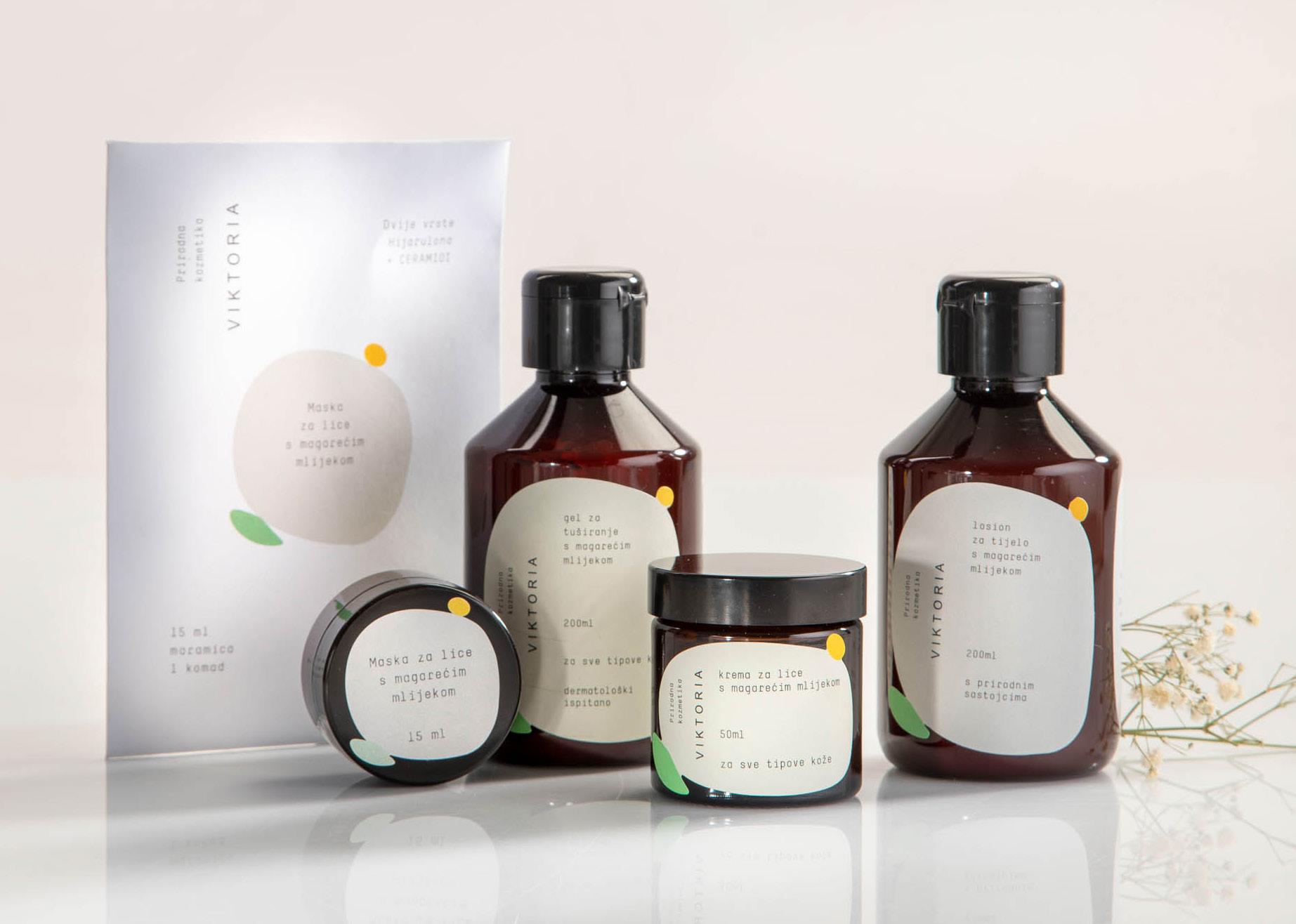
bestsellers for a long time, while a couple months ago the shower gel with donkey milk was awarded as the best in the category body care, by Grazia Beauty Award.
We love donkey milk, and it is especially important to us that it comes from our happy donkeys. At the Viktoria farm, we produce our own milk, so our creams contain liquid gold from animals that we raised and cared for with our own hands. Traceability, proven quality and quiet luxury from the heart of nature in the Dalmatian hinterland - this is what defines our premium cosmetics.
The quiet luxury that Viktoria cosmetics exudes, can also be experienced through our honesty shop in Radučić, “Viktoria's Corner”, which is also a showroom, and where you can enjoy contact with nature and Viktoria cosmetics undisturbed. We successfully sell donkey milk cosmetics in all Spar stores throughout Croatia.
n Are you satisfied with what you've achieved?
Of course we are! We achieved the closure of the production cycle and realized premium cosmetics for which the market has only words of praise - we can freely say that we are happy, not only satisfied. It is also a great satisfaction to receive prestigious awards such as Entrepreneur of the Year 2023 - Association of Business Women Krug; 2. place in the selection of the best young Croatian farmer – 2021 by Ministry of Agriculture; Best family owned business in Šibenik Knin County – 2020 by Ministry of Agriculture; as well as the Grazia beauty award for gel for a shower with donkey's milk, which was sold out immediately afterwards, and is currently being sold as part of a premium box on our webshop.
n What are you most proud of?
Our pride and motivation is our daughter Viktoria,
but also our customers. Their kind words, their comments. We have regular customers, and that is priceless. We are also proud of our face cream with donkey's milk, because we poured our hopes into it, which turned out to be very successful, and it has been in the first place of our bestsellers since its launch to this day. In addition to donkey milk, Viktoria face cream is also enriched with shea butter, which prevents transepidermal water loss and retains moisture in our skin, and olive oil is responsible for a touch of antioxidants. In addition, immortelle essential oil has an anti-inflammatory effect and promotes skin regeneration. Aloe vera, just like immortelle, is traditionally one of the longest-lasting soothing ingredients, so the cream will additionally soothe the face in the morning and evening routine. The cream has a gentle and smooth texture, and when applied to the face, a natural citrus scent mixed with immortelle flowers spreads. It is this combination that will wake up and cheer up all lovers of natural fragrances and make beauty rituals even more beautiful.
n Is there anything else you would like to add... wishes, plans...
Our plan is to expand distribution both in Croatia and abroad, primarily in concept stores that recognize the value of farm to face cosmetics. And our wish is, just a little more free time.
OPG Brankica Borović
Kutlače 15 Radučić 22304 Ervenik, Croatia
T. +385 95 512 5848 office@viktoria-naturally.com https://viktoria-naturally.com/
Brilliant Bases for Beautiful Brands: Stephenson Heads to in-cosmetics Global 2024
Stephenson, a leader in the manufacture and supply of a wide range of soap bases and ingredients for the personal care industry, is exhibiting at in-cosmetics Global 2024 promoting its range of melt & pour, cosmetic, liquid, and extruded bases under the theme: Brilliant bases for beautiful brands.
Rob Carr, recently appointed Managing Director, commented: “This year is going to be a jam-packed event for our team. We will be showcasing the latest innovations in our Syndopal® range of extruded Syndet bases for the manufacturing of solid bars that meet today’s need for new sustainable solutions and Durosoft®, our line of naturally derived polyglyceryl esters. We’re also pleased to feature our new Syndopal® Natural MB in the Innovation Zone – perfect for creating a variety of cleansing bars, including shampoos, body washes, facial cleansers, and intimate care products - and our Durosoft® range in the Sustainability Corner.
“Our Marketing Manager, Tim Pulleyn, will be delivering a seminar on ‘Why consumers love waterless solid format products’ alongside Emma HeathcoteJames from Little Soap Company, one of the fastest growing companies in the toiletries sector. Tim and
Emma will be discussing why consumers are looking for a broader range of solid personal care products today and what these products can look like; a theme very much in tune with the growth in popularity of solid format body bars, cleansers, shampoos, and conditioners.” They will be speaking on Tuesday 16th April at 9.30 am in Theatre 1.
Located on Stand 1U118 at the Paris Expo Porte de Versailles venue from 16-18 April, the Stephenson team will be offering insight into the latest personal care product trends, guiding brands seeking to reformulate current products or considering the move to solid bar formats, as well as providing samples for attendees.
To book a meeting with any of the team at the event or to find out more about Stephenson products and ingredients, visit www.stephensonpersonalcare.com

Are Snow Mushrooms the New Hyaluronic Acid?
Snow mushrooms, also known as Tremella fuciformis, have been a staple in traditional Asian medicine for centuries, prized for their ability to promote youthful-looking skin. Renowned for their hydrating and anti-ageing properties, snow mushrooms offer a vegan alternative to hyaluronic acid.
Are you ready to discover a beauty secret that has been cherished in Eastern cultures for thousands of years?
Mushrooms can do wonders for the skin. They offer antioxidants, anti-inflammatory properties, and even brightening benefits. But let’s get into why tremella has recently taken centre stage in the beauty industry.
Snow mushrooms, also known as Tremella fuciformis , have been a staple in traditional Asian medicine for centuries, prized for their ability to promote youthful-looking skin. Renowned for their hydrating and anti-ageing properties, snow mushrooms offer a vegan alternative to hyaluronic acid.
Hyaluronic acid can hold 1000 times its weight in water, and snow mushrooms can hold 500 times its weight, however, snow mushroom’s gelatinous molecules are smaller than that of hyaluronic acid, so they penetrate the skin much better — leading to more noticeable, real-world results. In other words, snow mushroom holds less water than hyaluronic acid, but it delivers more moisture to the skin due to the smaller particle size.
Benefits of snow mushroom for skin
Renowned for their gelatinous texture and moisture properties, snow mushrooms are celebrated for their ability to hydrate, plump and rejuvenate the skin. Also, scientific research supports the efficacy of snow mushrooms in skincare. A study published in the Journal of Cosmetic Dermatology investigated the moisturizing effects of snow mushroom extract on human skin. Researchers observed a significant increase in skin hydration and elasticity, attributing these benefits to the polysaccharides present in snow mushrooms.
Hydration
What sets snow mushrooms apart from other skincare ingredients is their water retention capacity. Mushrooms can hold up to five times their weight in water, making them an invaluable addition to hydration properties. By forming a protective barrier on the skin's surface and replenishing moisture levels deep within the dermis, mushrooms offer long/ lasting hydration that restores the skin's natural radiance.
Antioxidant powerhouse
In addition to their moisturizing properties, they contain antioxidant properties Research published in the Journal of Medicinal Food demonstrated the ability of snow mushroom polysaccharides to scavenge free radicals and reduce oxidative stress, thereby protecting the skin from premature aging and environmental damage. These antioxidant-rich compounds work synergistically to promote skin health leaving a youthful complexion.
Brightening benefits
Snow mushrooms are a perfect ingredient as they contain brightening properties from kojic acid. Kojic acid is found naturally in many fungi and is used as a skin-lightening agent because it helps inhibit the production of melanin, the pigment that gives skin its colour. Snow mushroom, being an excellent source of kojic acid, can help to reduce the appearance of dark spots and hyperpigmentation, leaving the skin looking brighter and more radiant.
Snow mushroom stand as a testament to the power of nature to nurture and revitalize skin. Backed by scientific research and centuries of tradition, these humble fungi have earned their place in modern skincare. We invite you to explore the transformative benefits of snow mushrooms and embark on a journey to radiant and healthy skin.
Elevate your skincare routine with the natural potency of snow mushroom and notice the transformative difference with our Shroom Serum.

Lilly obrt za proizvodnju Ulica grada Vukovara 239a/2
Zagreb, Croatia
Ana Lilly, Founder
T. +385 97 6762 560 info@analilly.com

https://analilly.com/ https://www.facebook.com/analillyskincare https://www.instagram.com/analilly_skincare/
medicinal plants photo herbarium
Daisy
Daisy, esteemed for its medicinal properties, carries a rich historical heritage as a medicinal plant, while a multitude of pharmacological actions stem from its various parts.
Bellis perennis , commonly known as the daisy, is a European species of flowering plant in the Asteraceae family.
It is a perennial herbaceous plant that grows up to 20 centimetres (8 inches) in height. It has short creeping rhizomes and forms rosettes of small, rounded or spoon-shaped leaves that grow flat to the ground. The plant blooms from April to October, and its flowers exhibit heliotropism, following the position of the sun in the sky. The flowerheads are composite, with white ray florets (often tipped red) and yellow disc florets.
The leaves of daisies have an ovate, elongated shape and are of a deep green color with a length of up to 4 cm (1.6 in) with a width of 2 cm (0.8 in). Likewise, the leaves are arranged as a basal rosette and grow upright in the air. The stems of the plant are rarely hairy and generally leafless.
Bellis perennis is commonly found in lawns, grassy areas, and close-cropped grasslands. It is difficult to eradicate by mowing, which is why it is sometimes called “lawn daisy.”
Daisy is a recognizable plant that adds beauty to meadows and lawns, and its appearance is a common sight on sunny days.
Habitat & cultivation
The daisy is native to the Mediterranean and Sout-
hern Europe. Even in ancient times, however, it came to Central Europe, as there were more and more meadows. The daisy family is today part of the original vegetation in Central Europe. It is widely naturalized in most temperate regions including the Americas and Australasia1
Daisies can be found on all continents except Antarctica. They usually inhabit grasslands, meadows, gardens, urban areas, and roadsides
Use for medicinal purposes
Traditional medicinal uses
It is a medicinal plant that has been used historically. The young leaves and flowers are edible, and the green buds can serve as a substitute for capers in cooking. Daisy has properties that help with eye and other inflammations, soothe coughs, act as a bactericide, and function as a mild laxative and antispasmodic. It is also used for wound healing and gentle care of children.
Constituents2
flavonoids
saponins
• triterpenes
• essential oil
• vitamins, minerals, and polysaccharides
Action and application
TAXONOMY
kingdom: Plantae
order: Asterales
family: Asteraceae
genus: Bellis
species: Bellisperennis
common name
Common daisy, Lawn daisy, English daisy
flowering time
IV - X month

The entire flowering plant of Bellis perennis has medicinal properties3 and various parts of the plant exhibit multiple pharmacological activities such as antimicrobial, nervous system, dermatological, antiinflammatory, cytotoxic, antioxidant, hypolipidemic, antihemorrhagic, hemolytic, and other effects. The antimicrobial activity of the aerial parts of the plant was studied using aqueous and ethanolic extracts through an in vitro method. The plant also has radical scavenging antioxidant properties, reducing activity, total antioxidant activity, and acts as an astringent. It reduces mucous production and has anti-inflammatory and fever-reducing effects, likely due to the presence of triterpene saponins4
References:
1 https://www.live-native.com/daisy/#Origin_and_occurrence_of_ daisies
2 https://weclinic.in/blog/bellis-perennis-uses
3 PDR for herbal medicines, Medical Economic Co. Montvale, New Jersey, 2000, 811.
